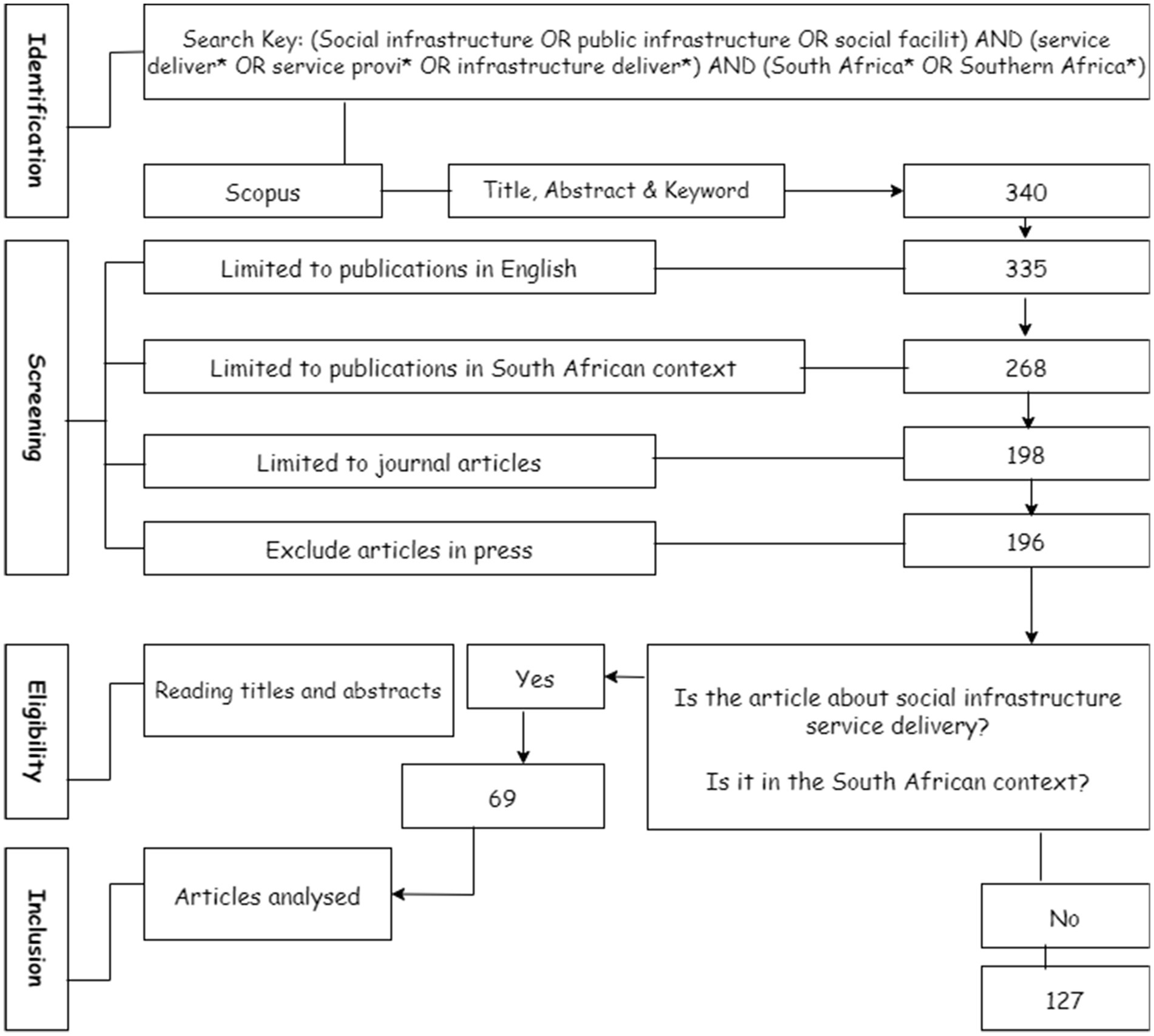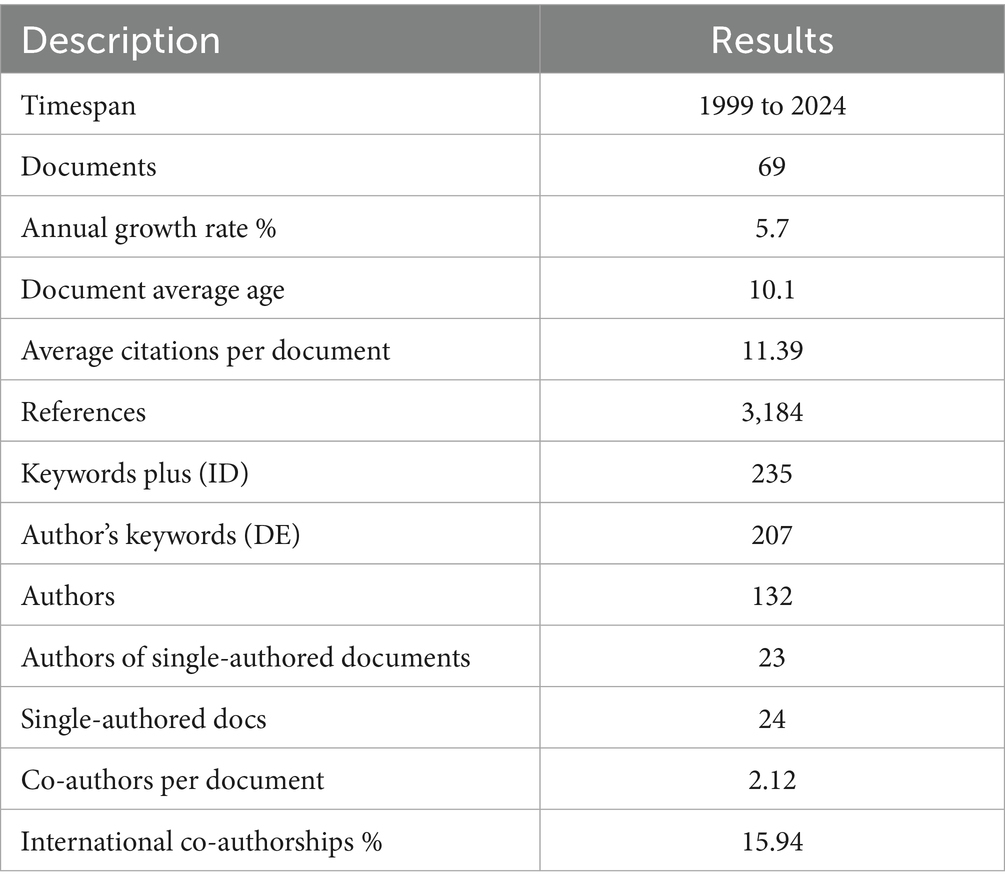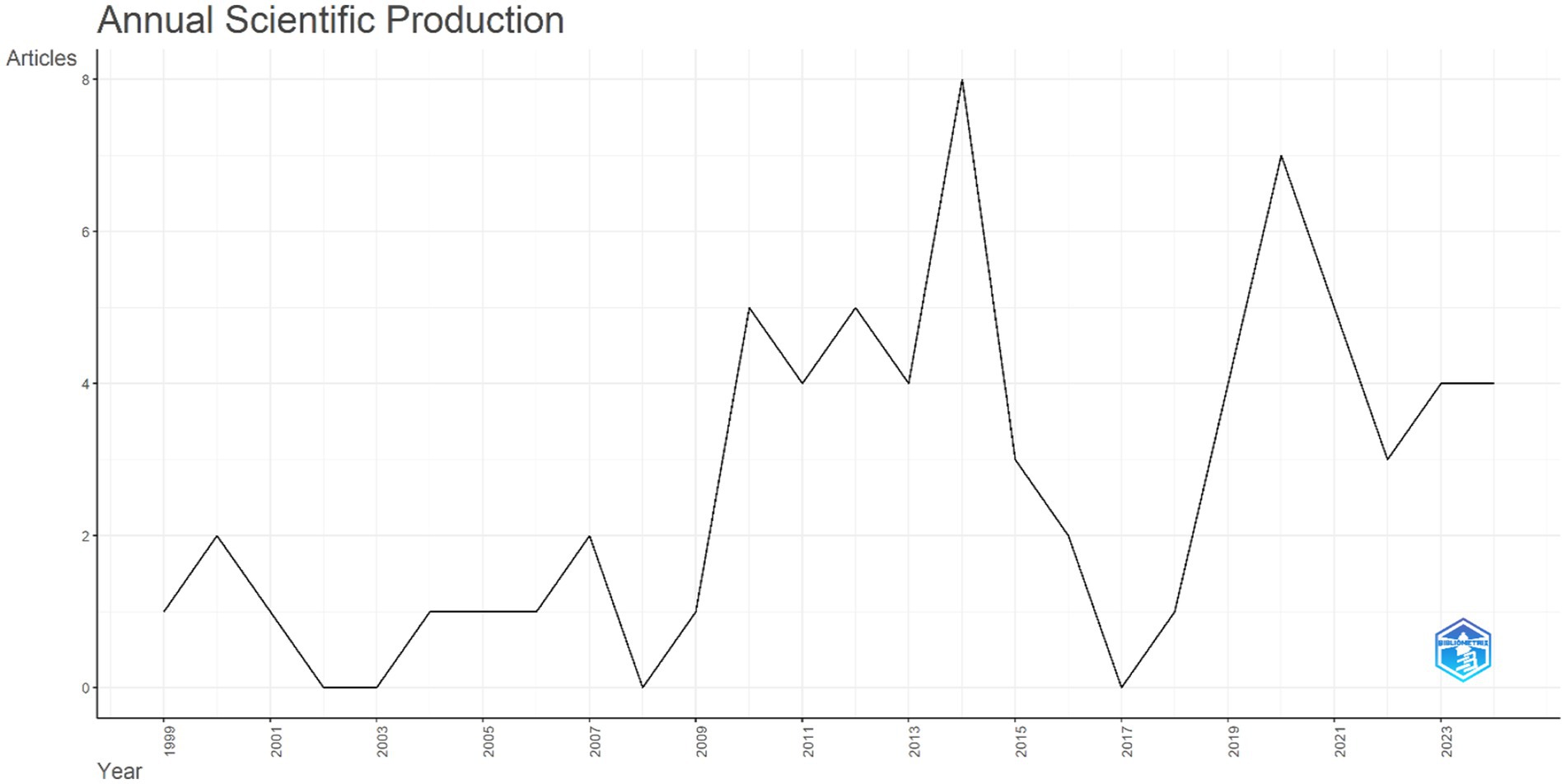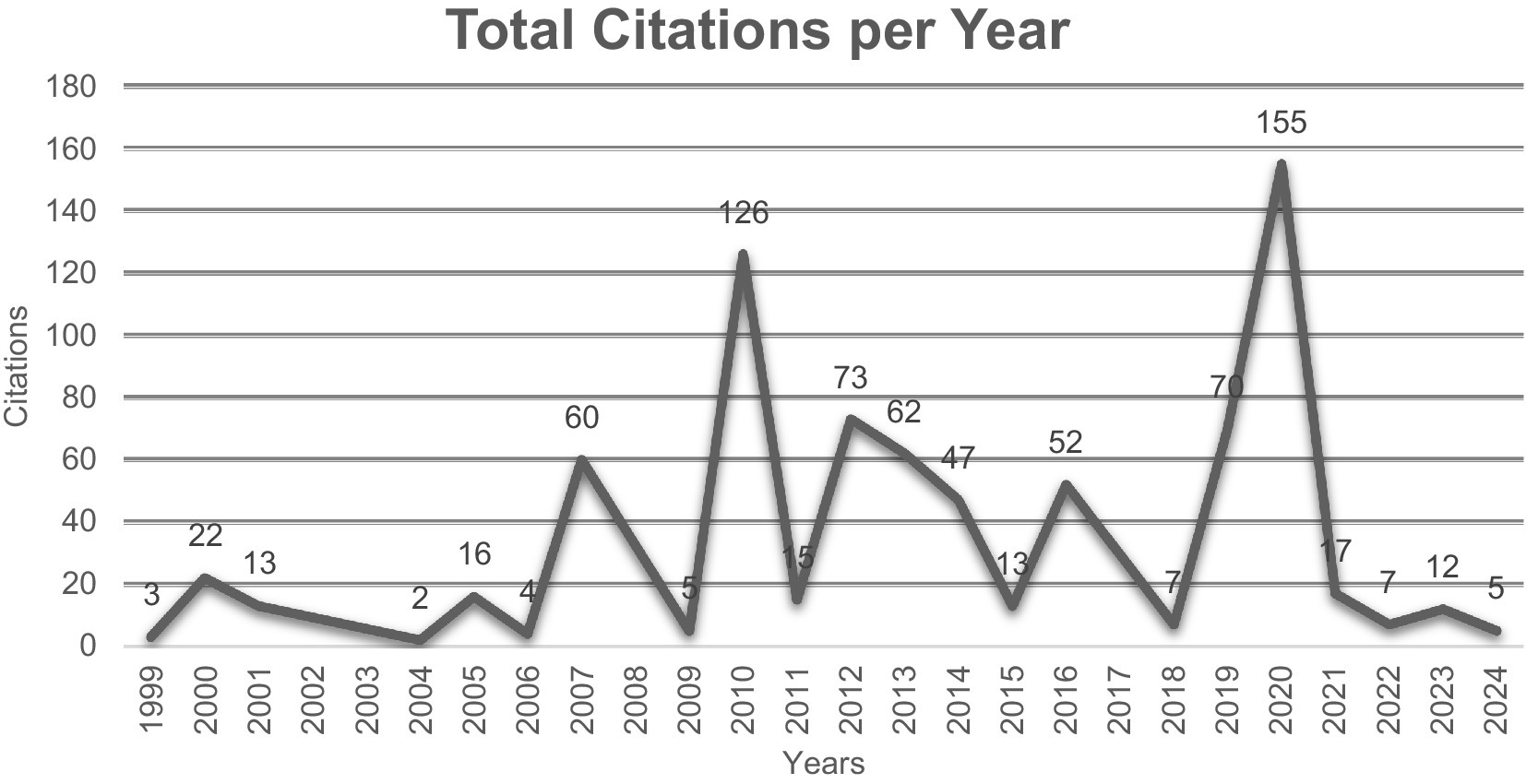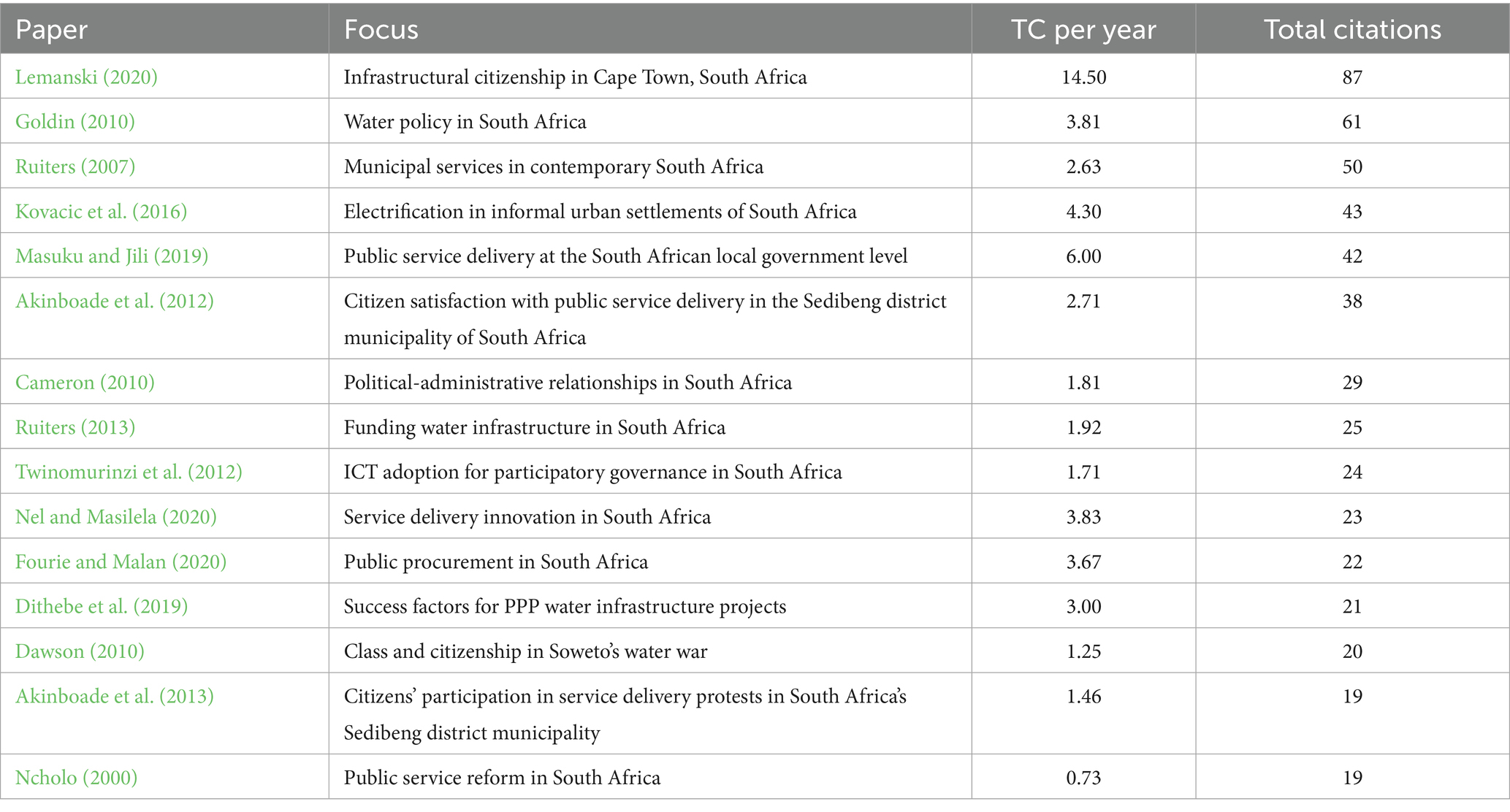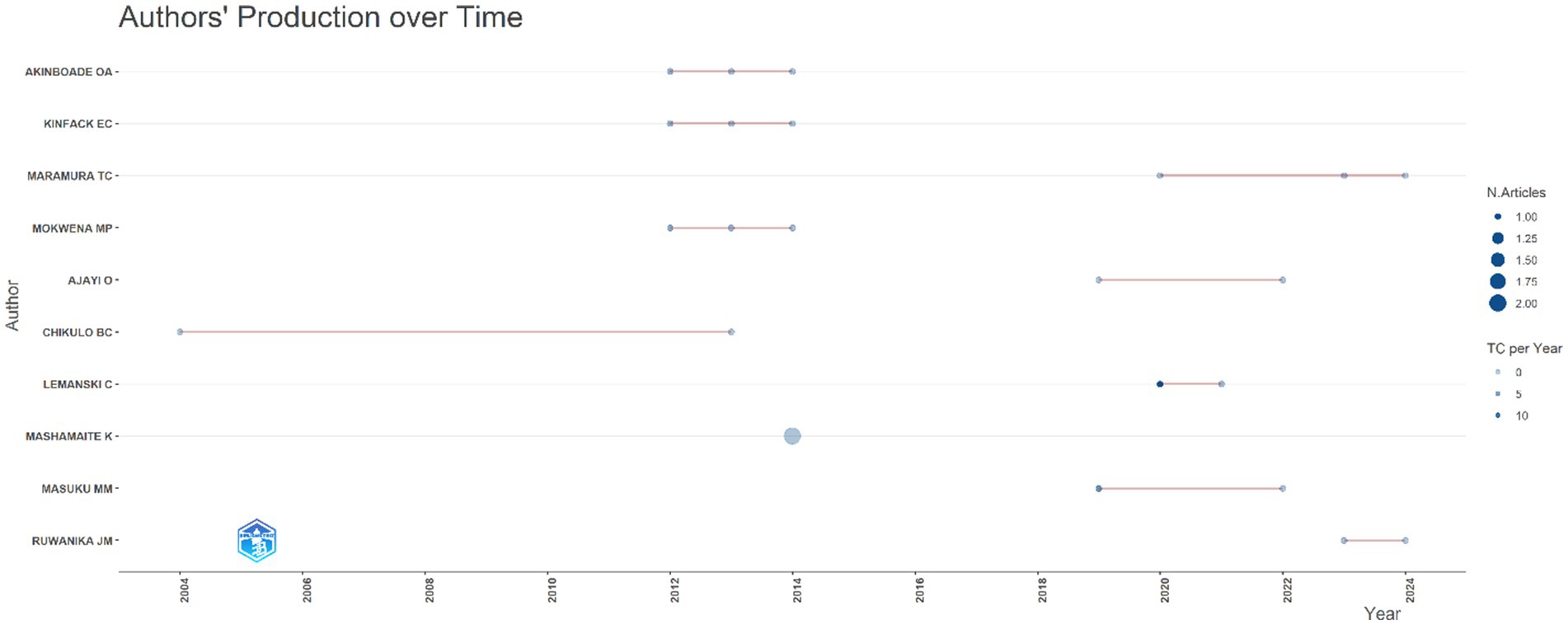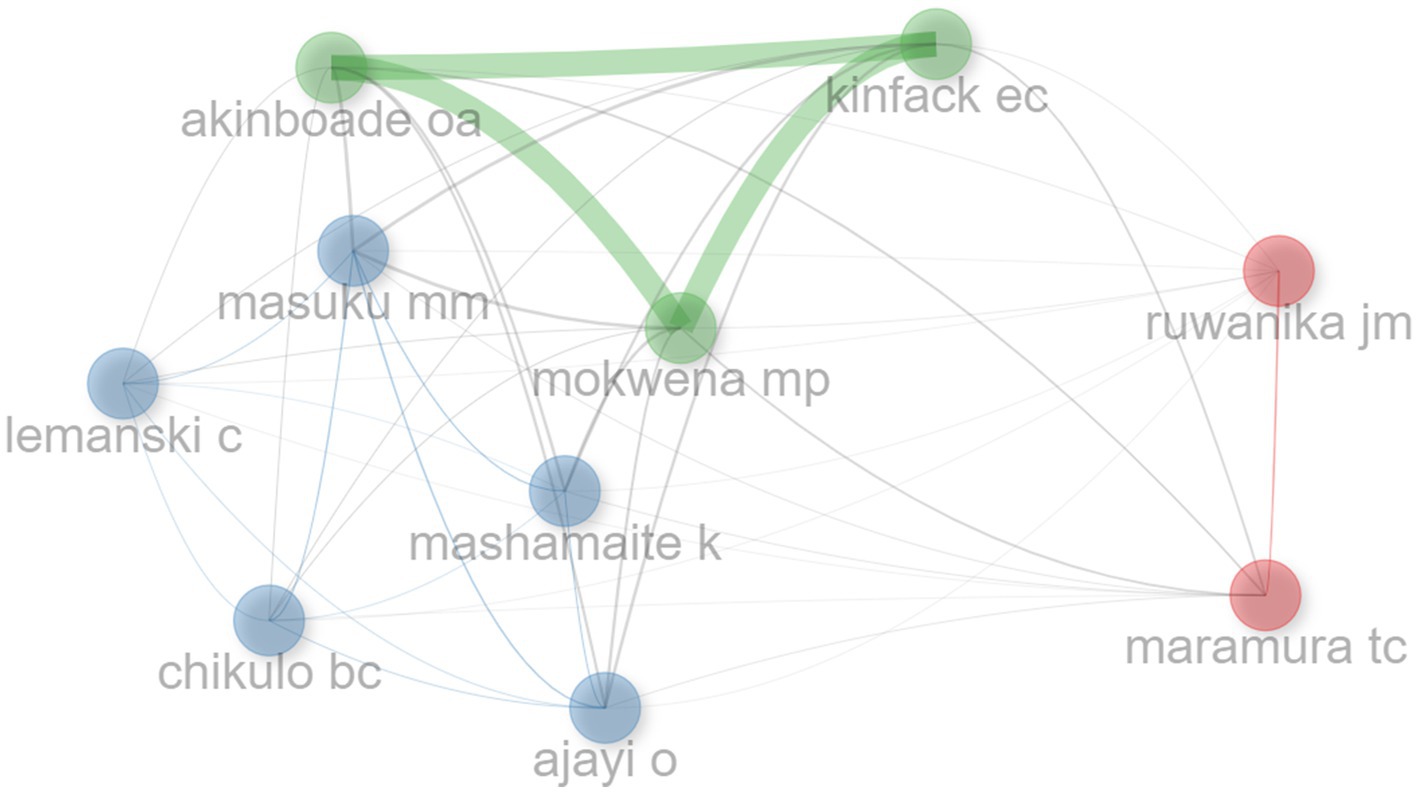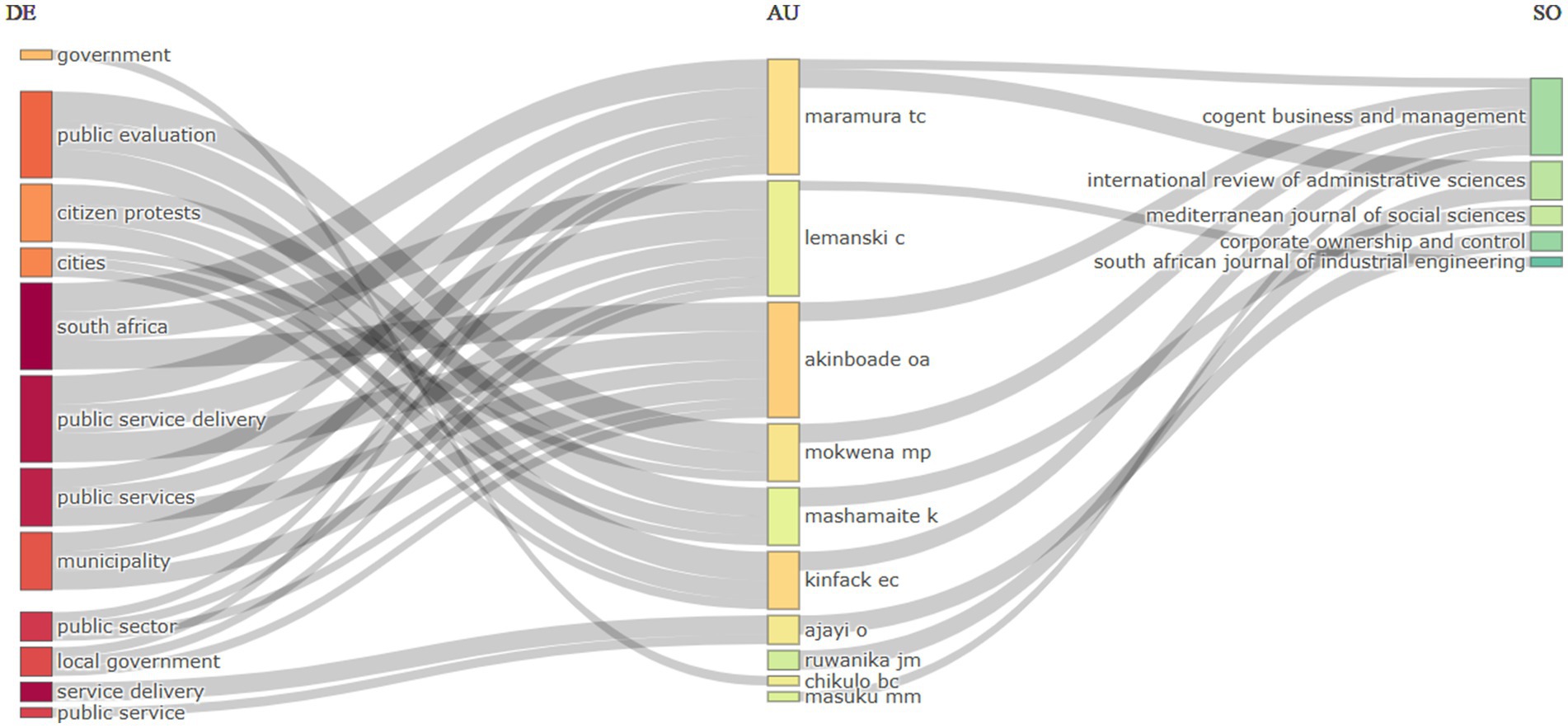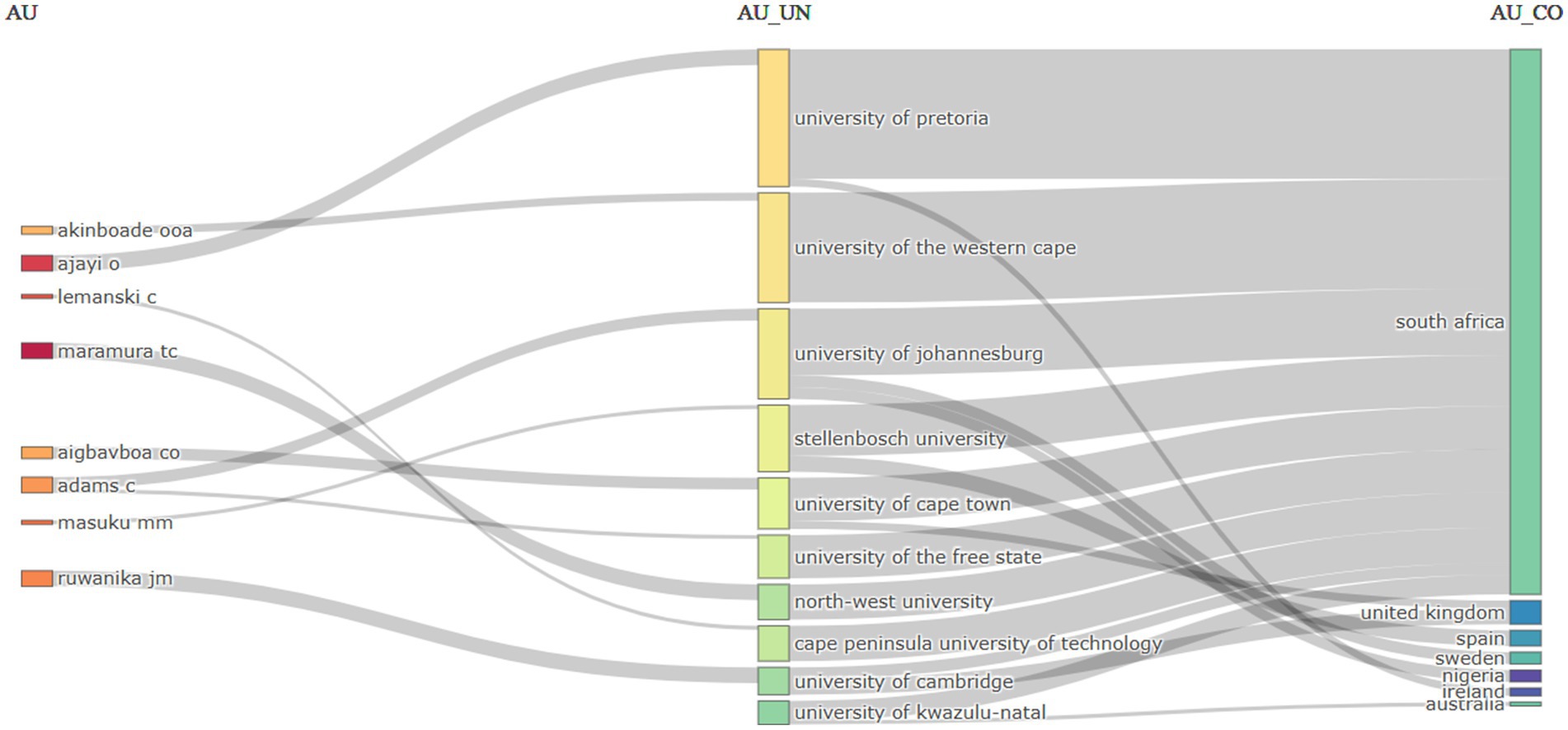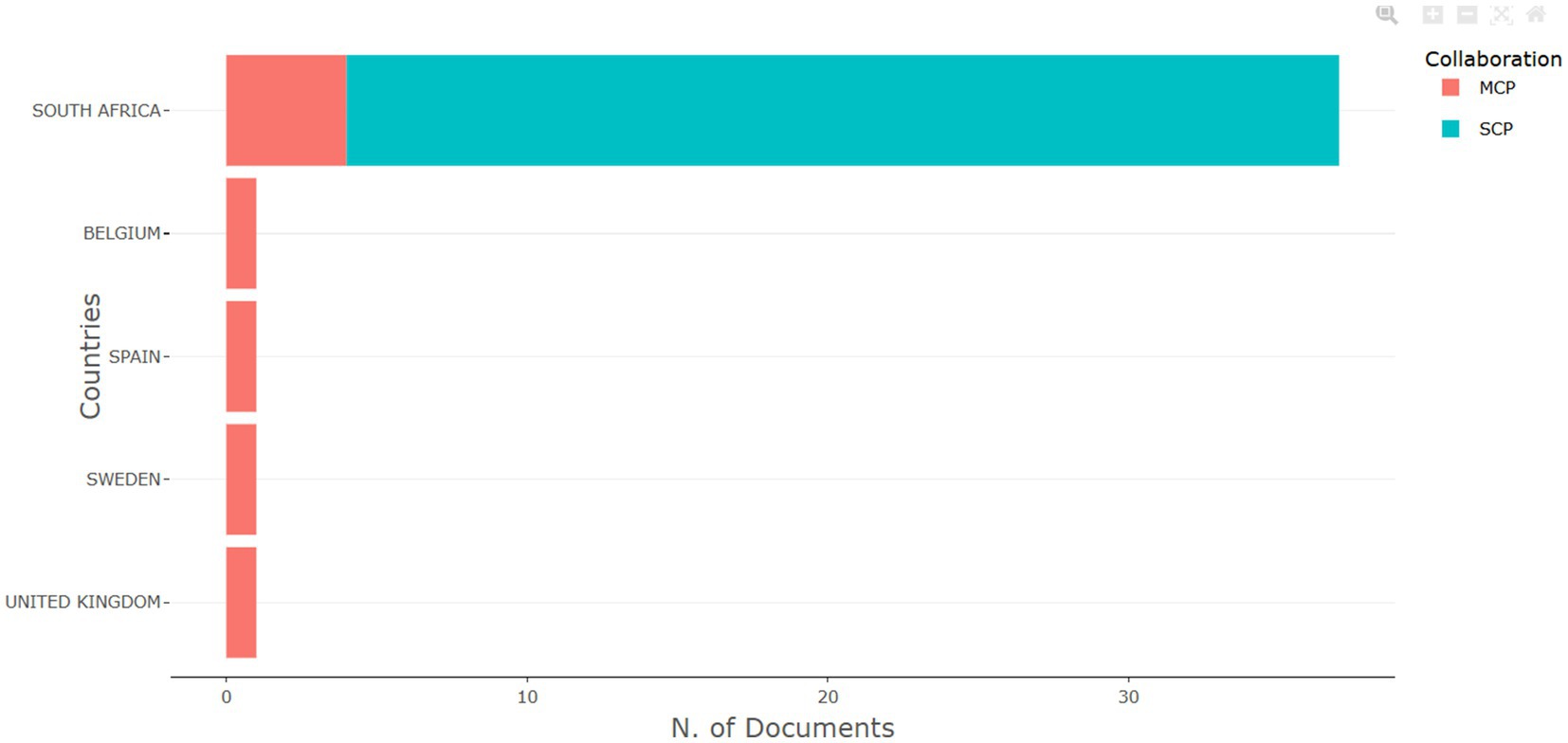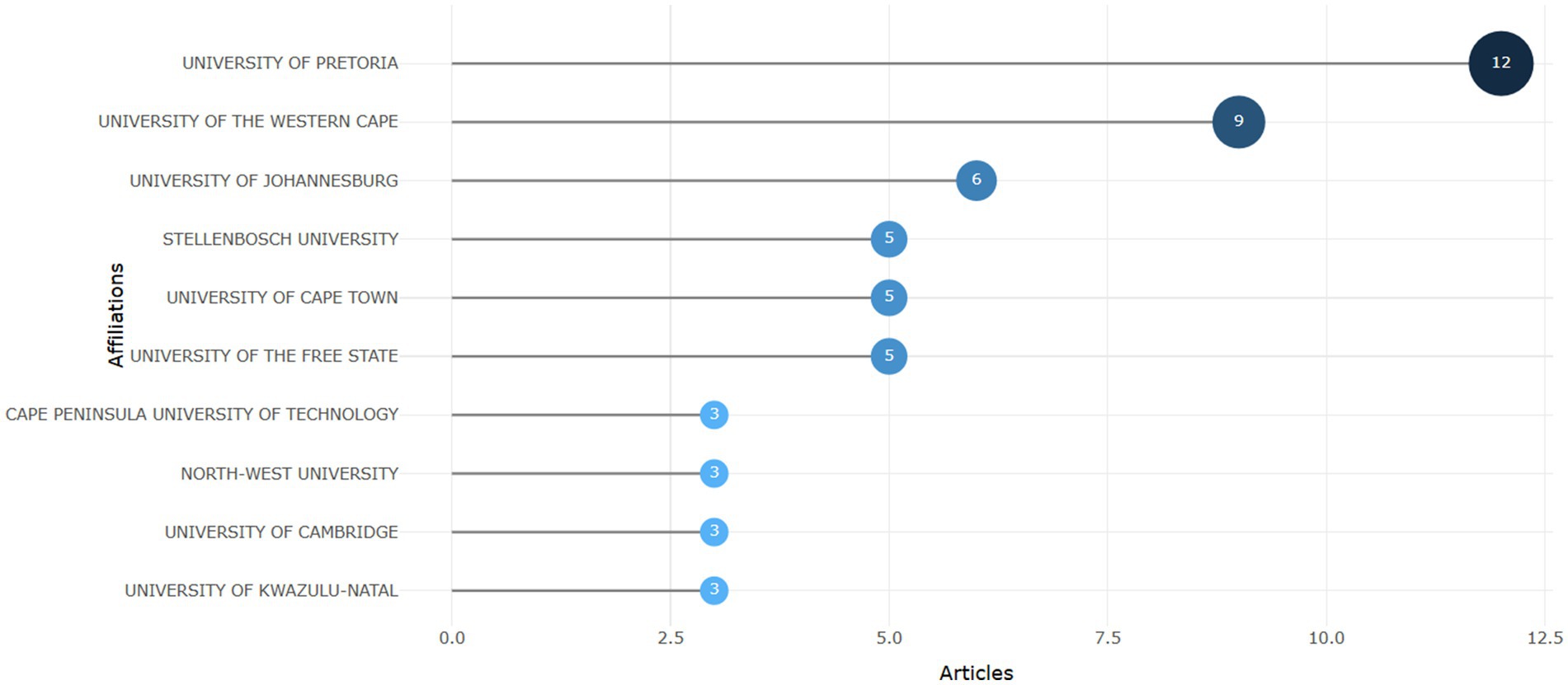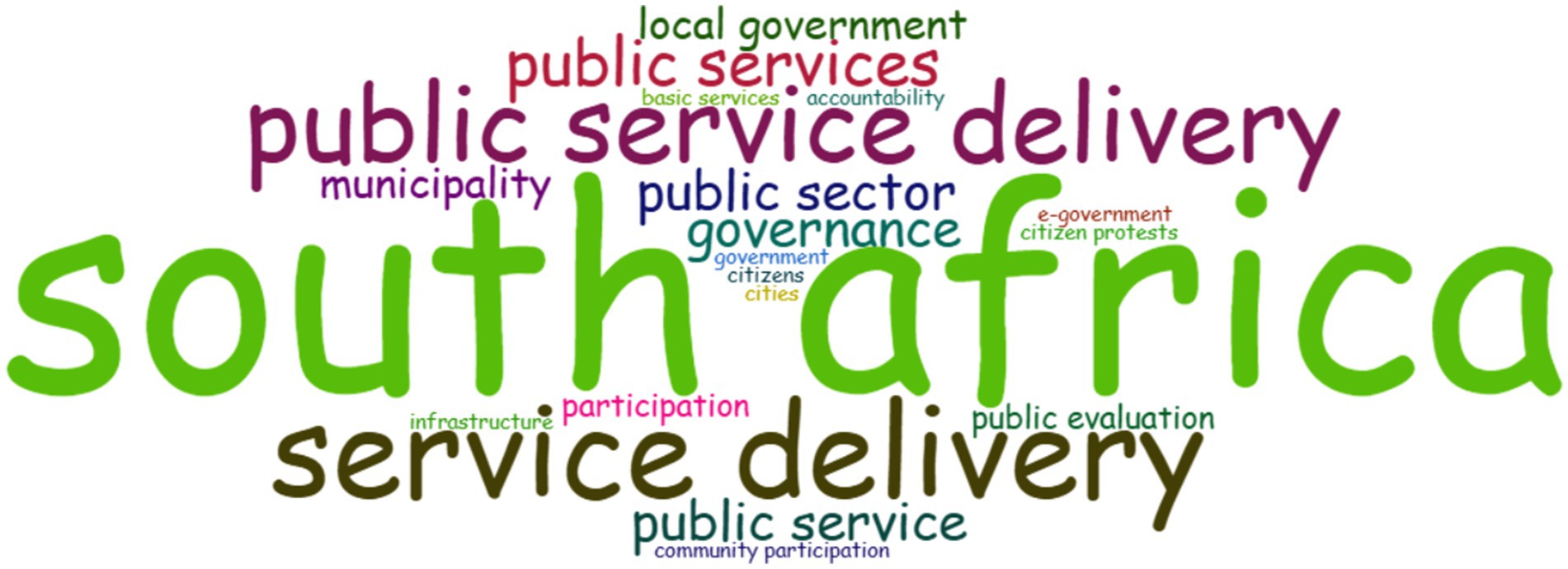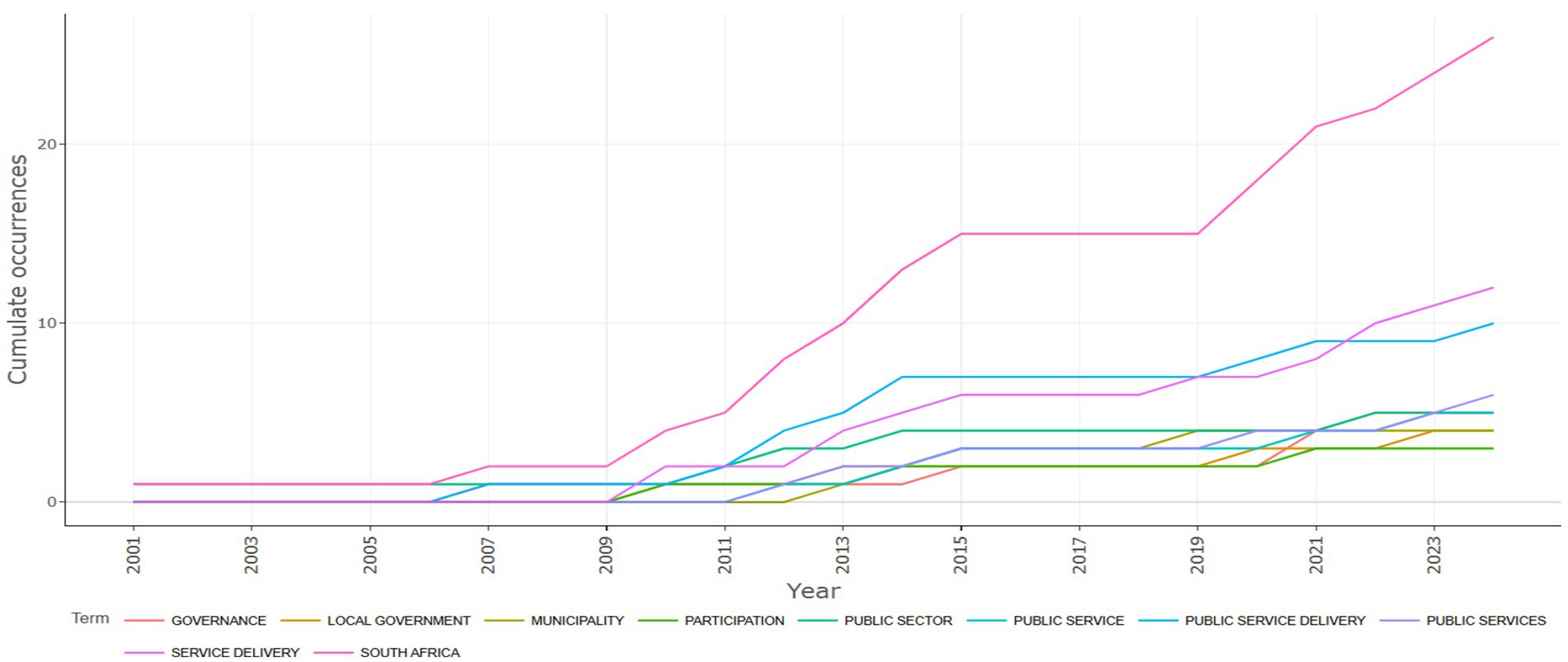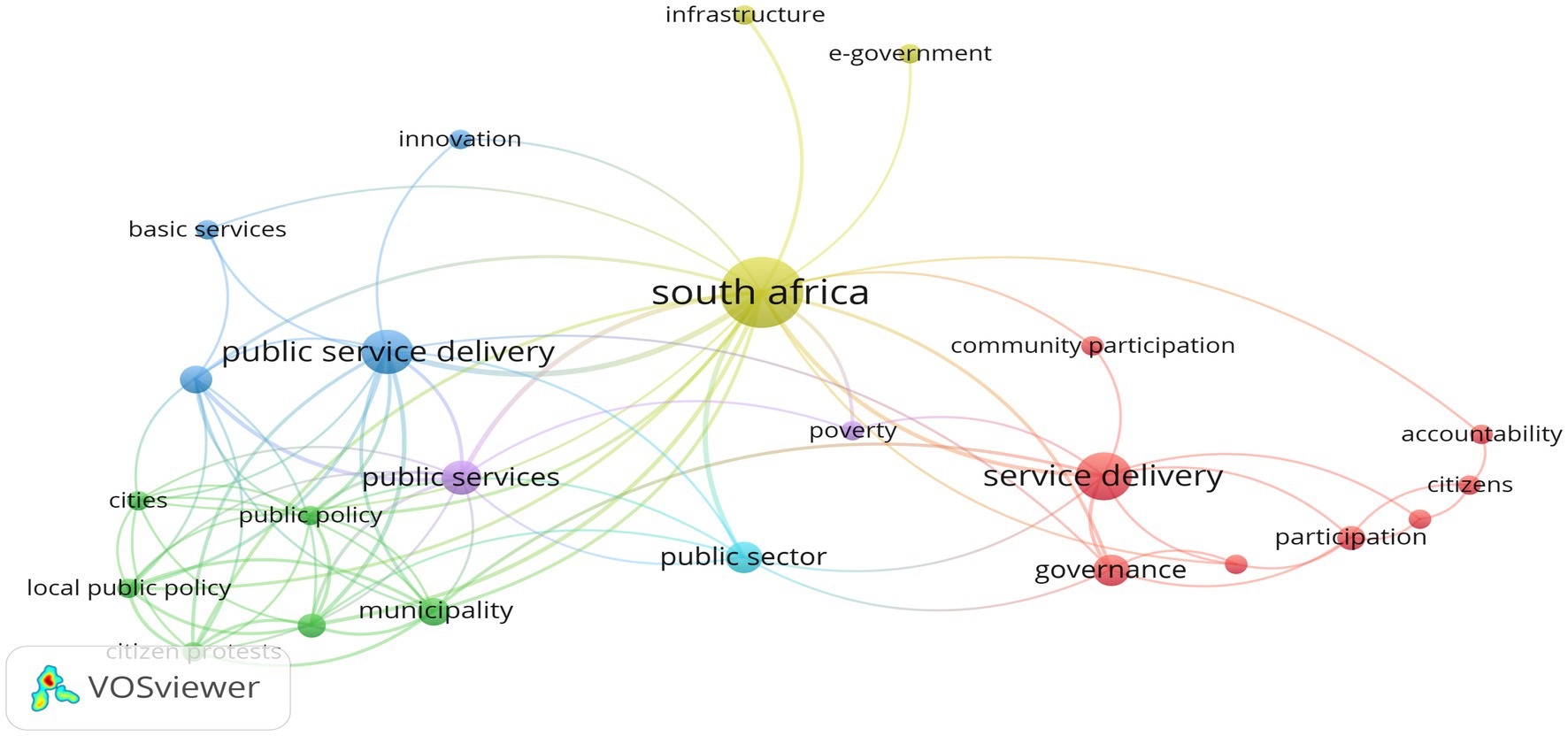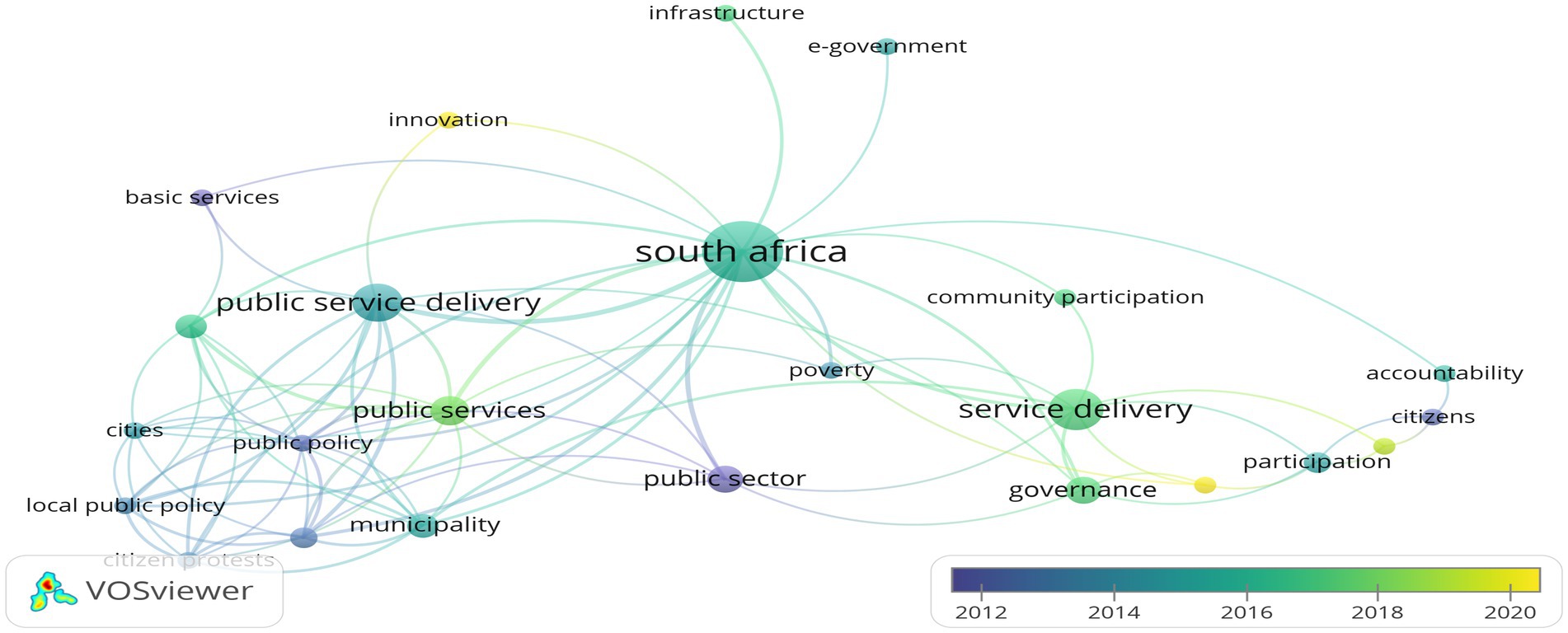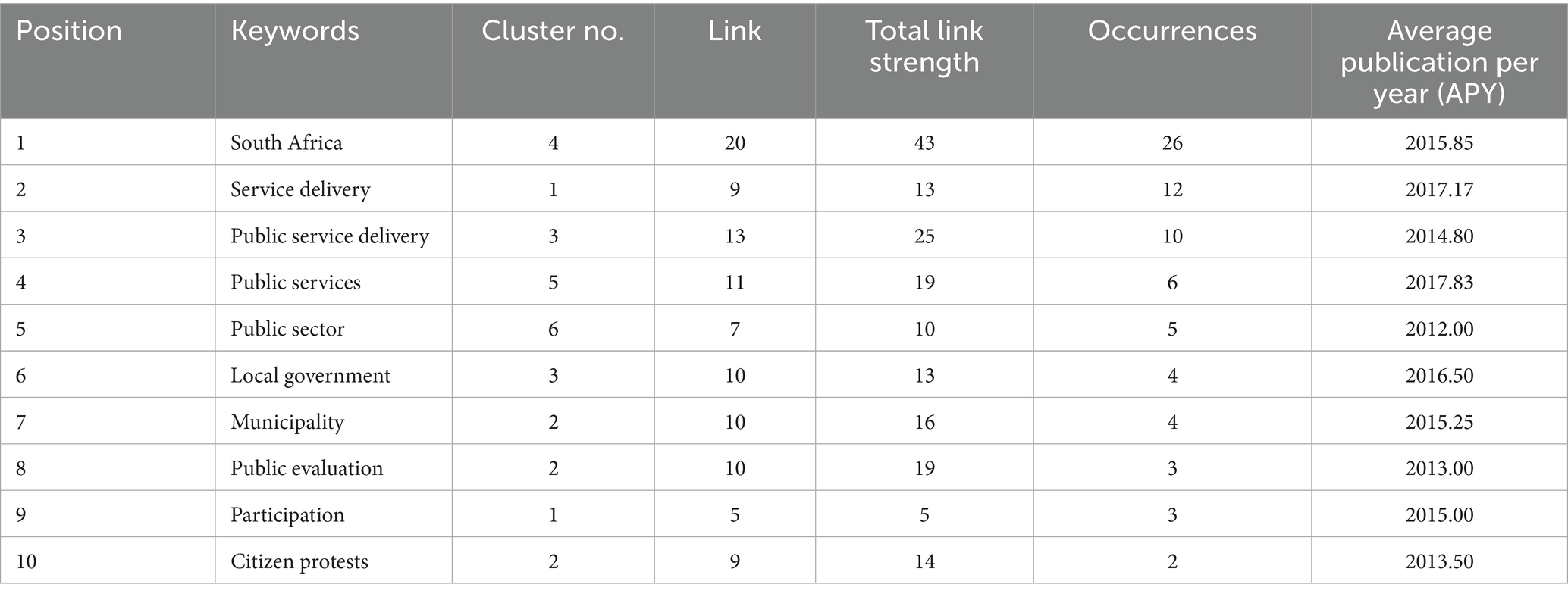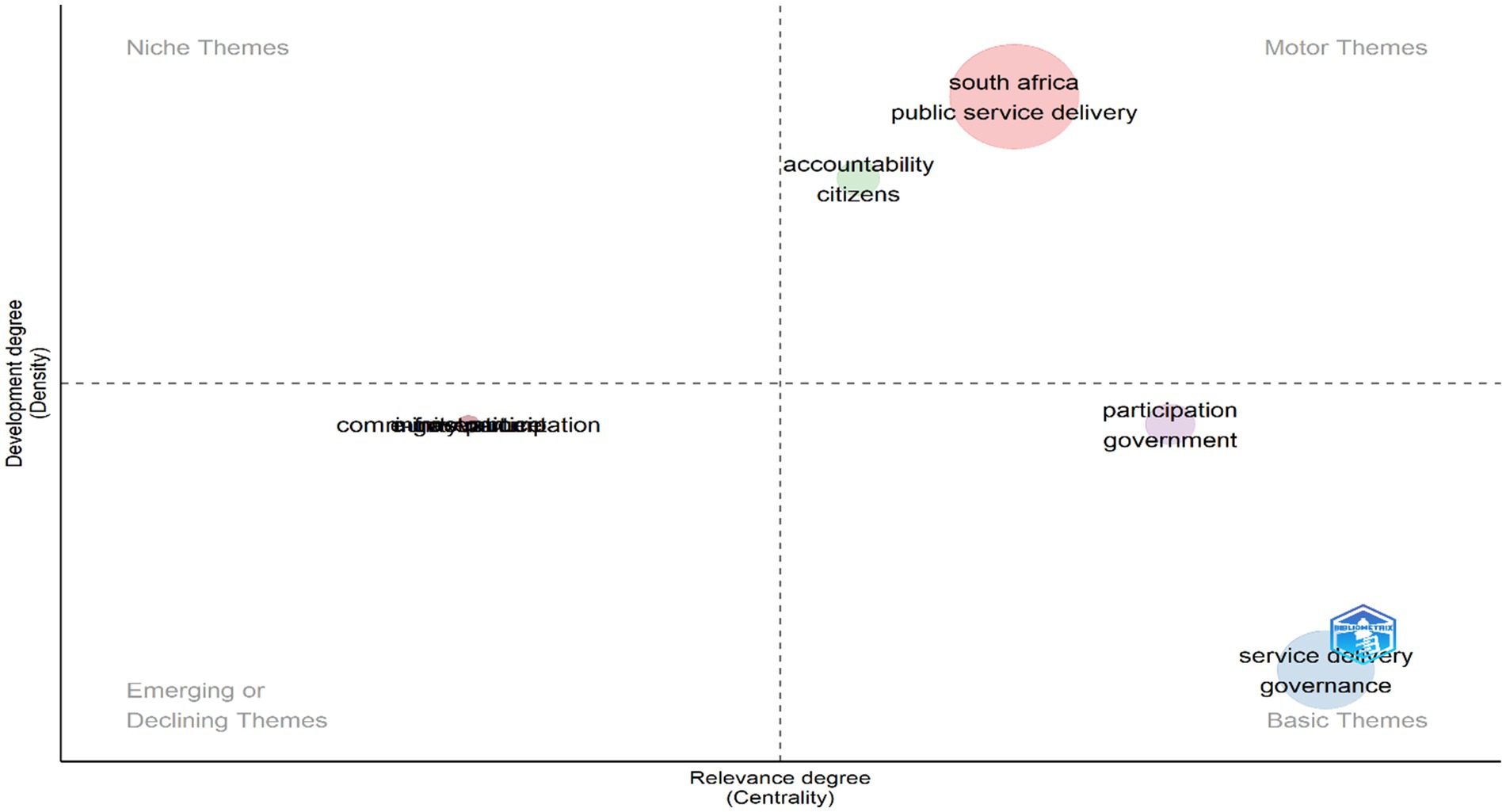- Department of Urban and Regional Planning, Faculty of Engineering and the Built Environment, University of Johannesburg, Johannesburg, South Africa
Introduction: This study conducted a bibliometric analysis of social infrastructure service delivery research in South Africa, using 69 Scopus-indexed journal articles published between 1994 and 2024.
Methods: In analysing the bibliometric data, Biblioshiny, VOSviewer, and Microsoft Excel were used to examine publication trends, prolific authors, and thematic developments in the field.
Results: The first Scopus-indexed article appeared in 1999, with publication rates showing modest growth in the first decade (1999–2009), followed by a significant acceleration, increasing by over 200% between 2010 and 2019. Citation analysis revealed a consistent impact across publications, with notable peaks in 2010 and 2020. Leading contributors include Akinboade OA, Mokwena MP, and Maramura TC. Their studies focused on citizen satisfaction, service delivery protests, and public service reform. Key research themes encompassed water policy and infrastructure, citizen participation in service delivery, public service innovation, and informal settlement services. The study identified research gaps in public service inclusion for disadvantaged groups and citizen roles in infrastructure maintenance.
Discussion: The analysis demonstrates that while research in this field has grown since South Africa’s post-apartheid transition, certain critical areas remain underexplored. Despite being limited to Scopus-indexed articles, the study provides valuable insights into the evolution and current state of social infrastructure service delivery research in South Africa. The findings clarify the understanding of the literature landscape and establish a foundation for future research directions.
1 Introduction
In current times, empirical contributions are becoming voluminous, fragmented, and controversial, thereby requiring scientific mapping for proper coordination (Albugami et al., 2024; Aria and Cuccurullo, 2017; He et al., 2025). It is from this need that bibliometric analysis has assumed relevance. Specifically, research in the field of social infrastructure service delivery in South Africa is plagued by literature complexity, and it is in addressing this that this study conducted a bibliometric analysis of 69 journal articles indexed in the Scopus database to pursue the following objectives:
i. Examined the characteristics of the research domain of social infrastructure service delivery in South Africa, considering the scholarly articles, authors, and affiliations that exert the most influence.
ii. Explored the dominant and emerging keywords or themes within the research field of social infrastructure service delivery in South Africa; and
iii. Identify the principal research topics, knowledge gaps, and directions for future research in the field of social infrastructure service delivery in South Africa.
Specifically, an elaborate literature search was conducted using a search string formulated from relevant keywords such as social infrastructure, service delivery, and South Africa. PRISMA inclusion and exclusion criteria were adopted in scaling the retrieved documents down to only relevant and concise journal articles. In the analysis of the articles, Biblioshiny, a component of R tools, VOSviewer, and Microsoft Excel were adopted. Findings from the study showed that authors with profound articles about the study were Akinboade OA, Mokwena MP, Maramura TC, and Kinfack EC.
Furthermore, the available literature on the subject focuses on social infrastructure service delivery, specifically citizen-centric public service delivery mechanisms, innovative transformation of service delivery, and infrastructure governance in South Africa, as well as collaborative governance for effective service delivery in South Africa. Areas with little research attention included ensuring public service inclusion for citizens in disadvantaged groups and the role of the citizens in the maintenance of public infrastructure, which is grossly lacking in South Africa. However, this study is limited given that it adopted only journal articles from the Scopus database, leaving out several valuable studies in other databases. Despite this, proper methodological profiling of the adopted process was ensured in this study. This gives room for other studies to target other databases for a similar investigation, thereby allowing for comparison among studies on the subject.
The findings of this study eliminate the initial complexity associated with the literature on social infrastructure service delivery in South Africa.
2 Research methodology
2.1 Research approach
In this study, a bibliometric analysis of 69 journal articles published between 1994 and 2024 was used to achieve the study objectives. In pursuit of the first objective, a quantitative analysis was conducted to reveal the prolific scholarly articles, authors, and affiliations making significant contributions to the field of social infrastructure service delivery research in South Africa. Furthermore, the study subsequently adopted a qualitative method to gain deep insight into the recurring keywords, themes, gaps, and future research trends on the subject. In this qualitative method, in-depth content analysis and thematic review were observed as common in bibliometric analysis (Agyei et al., 2024; Albugami et al., 2024; Barik, 2025; Bhati et al., 2025; He et al., 2025; Khan et al., 2025).
In addition, the Preferred Reporting Items for Systematic Review and Meta-Analyses (PRISMA) were used in the selection of articles suitable for the achievement of the objectives of the study. As held by Agyei et al. (2024), Bhati et al. (2025), and Mufungizi et al. (2023), PRISMA is best adopted when the focus is on ensuring a clear and concise criterion for article selection. Furthermore, this study relied on the Scopus database for article search and retrieval. As held by Agyei et al. (2024), Barik (2025), and He et al. (2025), using a single database in a bibliometric analysis assists a researcher in mitigating the errors likely to emerge when combining bibliometric data from multiple databases. Furthermore, social infrastructure service delivery is an interdisciplinary concept, and on this, Scopus offers an extensive range of content across different disciplines (Agyei et al., 2024; Liu et al., 2025). Lastly, several bibliometric studies have relied on only this database to produce insightful and impactful scholarly works (Agyei et al., 2024; Albugami et al., 2024; Bhati et al., 2025; Liu et al., 2025; Mufungizi et al., 2023; Sharma, 2025; Vătămănescu et al., 2024).
2.2 Data collection
In the collection of articles for this study, PRISMA with precise inclusion and exclusion criteria was adopted (Albugami et al., 2024; Bhati et al., 2025) to ensure the inclusion of appropriate studies, and specific keywords relevant to social infrastructure service delivery research in South Africa were adopted. These keywords range from social infrastructure to service delivery in South Africa. It was around these keywords that a Boolean search string was formed, as indicated in Figure 1. The literature search was conducted on Thursday, 9th January 2025, at about 10:48 am. Adequate attention was placed on including only articles published between 1994 and 2024. The idea of 1994 stemmed from the understanding that this was the year South Africa gained its political independence from Britain. All publications before this period would not reflect the notion of an equitable social infrastructure service delivery in the country, given the prevalence of apartheid during those periods. Also, articles in press were excluded to enable the study to focus only on published works, as equally demonstrated by Agyei et al. (2024), Albugami et al. (2024), Barik (2025), and Bhati et al. (2025).
As a result of the search on the Scopus database, there were 340 documents with emphasis on the title, abstract, and keywords parameters. In streamlining these documents, this study employed a five-step approach, as also adopted by Agyei et al. (2024) and Bhati et al. (2025), as illustrated in Figure 1. The inclusion criteria were based on English-language journal publications. In extension, therefore, the study excluded documents published in other languages and non-journal articles such as reviews, conference papers, book chapters, editorials, and articles in the press. These parameters have assumed popularity in several bibliometric studies (Agyei et al., 2024; Bhati et al., 2025). The argument against other documents aside, journal articles have a lack of stringent review and basic data required for a bibliometric analysis (Agyei et al., 2024; Albugami et al., 2024). Flowing from Figure 1, 69 articles were analysed using the R tool for Bibliometric and VOSviewer software, as equally adopted in the works of Agyei et al. (2024), Albugami et al. (2024), and Wani and Ganaie (2025).
2.3 Data analysis
In this study, Biblioshiny, a component of R tools (Albugami et al., 2024; Aria and Cuccurullo, 2017; Huang, 2025; Khan et al., 2025; Vătămănescu et al., 2024), is adopted in presenting the bibliometric descriptive statistics of the adopted articles. In visualising the keywords’ co-occurrence network and overlay, VOSviewer has assumed prominence (Barik, 2025; Bhati et al., 2025; He et al., 2025; Khan et al., 2025; Mufungizi et al., 2023; Rizelioğlu, 2025; Sharma, 2025; Van Eck and Waltman, 2023); thus, it was used in this study. Furthermore, this study leveraged the prowess of Microsoft Excel 2021 to produce a few graphs. The combination of these tools has assumed prominence in most bibliometric studies, given their capacity to handle complex graphs, keyword counts, and map scientific relationship networks (Agyei et al., 2024; Albugami et al., 2024; Aria and Cuccurullo, 2017; He et al., 2025; Mufungizi et al., 2023; Vătămănescu et al., 2024). These tools were used to generate the annual scientific production over time, three field plots, co-authorship networks, and the thematic map. Another visualisation feature generated was the keyword co-occurrence network and overlay map. Finally, the analysis concluded with an in-depth qualitative discussion of the adopted articles, exploring dominant research areas, knowledge gaps, and areas for further research on social infrastructure service delivery in South Africa.
The mixed-method approach adopted in this study, combining bibliometric analysis with qualitative thematic discussion, serves multiple critical functions that enhance the research’s validity and practical utility. The quantitative bibliometric component, utilizing Biblioshiny and VOSviewer, provides objective mapping of research trends through statistical analysis of publication patterns, keyword co-occurrence networks, and collaboration landscapes (Aria and Cuccurullo, 2017; Van Eck and Waltman, 2023). This macro-level analysis reveals dominant themes, knowledge gaps, and the evolution of scholarship over time in social infrastructure service delivery research. The qualitative component then adds depth to these findings by interpreting the bibliometric results within South Africa’s specific socio-political context, explaining why certain research trends have emerged and how they relate to real-world infrastructure challenges. This dual approach enables comprehensive triangulation of findings, where quantitative patterns are validated and enriched through qualitative insights.
The methodology particularly addresses the limitations inherent in using either approach independently: while bibliometrics might identify research clusters, it cannot explain their contextual significance; conversely, purely qualitative analysis might lack the systematic breadth of bibliometric evidence. By integrating both, the study achieves a more nuanced understanding that bridges large-scale research patterns with granular, context-specific interpretations. This is especially valuable for policy-relevant research, as it combines measurable trends with actionable narrative insights. The approach aligns with established best practices in bibliometric research, where leading scholars advocate for mixed methods to fully capture both the quantitative and qualitative dimensions of scientific knowledge production. Ultimately, this methodology strengthens the study’s contributions by ensuring its findings are both empirically robust and practically meaningful for addressing South Africa’s social infrastructure challenges.
3 Results
In this study, two sections were created for presenting the features and the thematic analyses of the adopted publications. In the first, basic document analyses such as authors’ production, citation trends, affiliations, and collaboration networks were presented. These were to provide a clear audit of research trends (Khan et al., 2025; Vătămănescu et al., 2024) on social infrastructure service delivery research in South Africa. In the second section, a proper discussion of the research themes was observed. In doing this, this study examined the keyword co-occurrences, networks, overlays, and thematic maps. In starting the result presentation, an overview of the adopted dataset was presented as captured in Table 1. As shown in the table, 132 authors have published research articles on social infrastructure service delivery research in South Africa, with 23 (17%) of the documents being produced by single authors and 109 (83%) being multi-authored. On average, each article had around two authors (2.12 authors per document), showing an appreciable level of collaboration among researchers on social infrastructure service delivery research in South Africa.
3.1 Social infrastructure service delivery research in South Africa
Social infrastructure refers to the basic facilities required for the delivery of efficient and effective public services (Imuezerua and Chinomona, 2015; Ajayi and De Vries, 2019). Given that the government is the largest service provider (Ajayi and Devries, 2022), there is a need for comprehensive service-support facilities capable of complex and bulk service delivery. In South Africa, municipalities are critical to service delivery. For instance, municipal services comprise an array of amenities provided to citizens residing in municipalities, such as water, electricity, housing, health, education, and waste management (Ingwani et al., 2024). However, delivering these facilities could be capital-intensive (Akinboade et al., 2012; Imuezerua and Chinomona, 2015). In South Africa, however, shortfalls in public service delivery are becoming common, thereby resulting in civic unrest, leading to significant economic losses and social discontent (Akinboade et al., 2012; Akinboade et al., 2013; Akinboade et al., 2014; Ajayi and Devries, 2022). To set the country on a solution pathway, the performance levels of service delivery must be measured with the aim of improving them. This measurement could be done by auditing contemporary literature on social infrastructure service delivery in South Africa to properly understand its scope and significance. Hence, this study adopts a bibliometric analysis approach.
In this subsection, an overview of the research field focusing on trends, prominent authors making significant contributions to the field, and their affiliations was presented. As captured in Figure 2, the publications’ growth over time is presented. On the figure, even though this study set the coverage time between 1994 and 2024 to capture the post-apartheid social infrastructure service delivery trend in South Africa, the first Scopus-indexed article on social infrastructure service delivery research in South Africa was recorded in 1999 (Kroukamp, 1999) and centred on Batho Pele, a traditional concept that meant putting the people ahead of all interests in the society. The paper examined the need to put the citizen first in transforming public service delivery in a changing South Africa. The 5-year interval between 1994 and the production of the first article on social infrastructure service delivery in 1999 may be due to the need to accommodate the service improvement gestation period after the unequal post-apartheid service deficiency experience.
In the first 10 years of publication on the subject (1999 to 2009), document production hovered around one to two articles, with no published articles in 2002, 2003, and 2008. Within this first decade, only 10 published articles were recorded on the Scopus database. This showed a struggling period for social infrastructure service delivery research in South Africa. In the subsequent 10 years, however, the research area experienced a considerable growth in article publication from just 10 to 36. This is an outstanding increment of over 200% between 2010 and 2019. Furthermore, from 2020 to 2024, 23 articles have been published showing the sustainability of the initial article production increase trend in social infrastructure service delivery research in South Africa.
In the analysis of the document citations, Figure 3 was prepared as shown below. As an invaluable component of bibliometric studies, citations present the extent of contributions that a study asserts in a research field (Agyei et al., 2024; Aria and Cuccurullo, 2017; Bhati et al., 2025; He et al., 2025; Huang, 2025; Khan et al., 2025; Mufungizi et al., 2023; Vătămănescu et al., 2024). Notably, the figure included citations for every document and year for which article publication was recorded. This demonstrated the relevance of all papers produced on the subject. Despite the acknowledgement of all articles with citations, there is variation in the citation pattern over the years. For instance, in 2010 and 2020, just a decade apart, the highest number of citations was recorded in the articles of Goldin (2010) that examined the role of the state in opening water policy networks and redressing issues of knowledge, power, and agency. The study argued that adequate awareness creation is necessary for ensuring an inclusive water policy framework. This article recorded a total of 61 citations with 3.81 citations per year, as observable in Table 2. In addition, Lemanski’s (2020) article on infrastructural citizenship in Cape Town, with 87 citations and about 15 citations per year, discusses the multiple ways that citizenship and infrastructure relate in diverse urban settings. He argued that this interaction has received limited critical attention. This study demonstrates how urban dwellers’ relationship to public infrastructure in the domestic spaces of the home and settlement, and the temporal scale of the everyday, offers a representation of broader political identities and perceptions, framed through the language of citizenship.
In furtherance, the extract of the 15 most cited articles in Table 2 complements Figure 3 by demonstrating the scientific impacts of articles on the subject of this study. However, articles between 2021 and 2024 have recorded fewer citations. This trend aligns with claims by Agyei et al. (2024) that recent articles usually garner fewer citations than older ones.
Furthermore, the 15 articles with the highest citations in the field of social infrastructure service delivery in South Africa, as captured in Table 2, discussed varied aspects of the subject. Prominent among these were water policy and infrastructure (Dithebe et al., 2019; Goldin, 2010; Ruiters, 2013); citizens’ participation in enhancing service delivery (Akinboade et al., 2012; Akinboade et al., 2013; Dawson, 2010; Lemanski, 2020); public service delivery and informal settlement (Kovacic et al., 2016; Masuku and Jili, 2019; Ncholo, 2000; Ruiters, 2007); and public service innovation and procurement (Fourie and Malan, 2020; Nel and Masilela, 2020; Twinomurinzi et al., 2012).
In addition to recognizing widely referenced articles through citations in the scholarly community, regard is also paid to authors with multiple publications (Agyei et al., 2024). As depicted in Figure 4, 10 prolific authors with multiple articles on social infrastructure service delivery in South Africa were presented. For instance, in the figure, Akinboade OA., Mokwena MP., and Kinfack EC., affiliated with MANOL Advisory Research, Centurion, South Africa, and Pretoria, South Africa, jointly produced three articles on the subject of this study. Given this effort, they were rated 1st, 2nd, and 4th most prolific authors on the subject, respectively. The first joint paper from these authors in 2012 analyses citizen satisfaction with public service delivery in the Sedibeng district municipality of South Africa (Akinboade et al., 2012). The study adopted primary data gleaned using a structured sample of 1,000 respondents. These respondents were asked to comment on their satisfaction with public service delivery in health care, housing, water, electricity, solid waste removal, community services, or overall physical appearance of the community, cutting crime, and job creation. The study found that respondents are most dissatisfied with road maintenance, government efforts to create jobs, and reducing crime. The overall conclusion of this study is that citizens are grossly dissatisfied with public service delivery in the study area, even though respondents from Emfuleni local municipality hold more positive feelings about public service delivery around water, electricity, and solid waste.
In their second and third papers together, they examined citizen participation in public service delivery protests in the Sedibeng district municipality of South Africa (Akinboade et al., 2013, 2014). Using a structured sample of 1,000 respondents, the study found that the average level of satisfaction with public service delivery is quite low, just as established in their first article (Akinboade et al., 2012). Given this service deficiency trend, citizens have resorted to participating in protests. In the study, it was noted that service delivery protest participants had no option but to force the municipality to improve social service delivery.
Another prolific author with three articles on the subject and rated third in Figure 4 is Maramura TC. This author was with the Department of Public Administration, Faculty of Management and Commerce, University of Fort Hare (UFH), Bisho, Republic of South Africa, when this study was published. However, in 2021, she moved to the Department of Public Administration and Management, University of the Free State, Bloemfontein, South Africa, where she published two other articles on the subject. In her first paper, Maramura, while leveraging the existing literature on the poor service delivery trend in South Africa that has engendered the growth of protests across districts, proposed a new theory to address the service failure trend. Her proposition, tagged Mandelafying the public service in South Africa (Maramura et al., 2020), is grounded in values such as proper ethics, humanitarianism, transparency, accountability, empathy, and selflessness, which characterized Nelson Mandela. Her subsequent papers also focused on enhancing public service delivery through supply chain management (Maramura and Ruwanika, 2023) and upgrading the role of service providers in ensuring effective service delivery (Ruwanika and Maramura, 2024).
Figure 5 complements the presentation depicted in Figure 4 by establishing the co-authorship network among the articles adopted in this study. In the figure above, two prominent co-authorship networks can be observed, even though there are three clusters of green, red, and blue colours. As stated earlier and as confirmed in Figure 5, Akinboade co-authored three studies with Akinboade et al. (2012) and Akinboade et al. (2013, 2014), and they are clustered in green colour. Primarily, these studies were on the role of citizens in demanding efficient public service delivery in South Africa. Equally, Maramura, another prolific author on social infrastructure service delivery in South Africa, co-authored two works with Ruwanika, and they are clustered in red colour. Their studies examined the challenges with supply chain management and the role of service providers in enhancing public service delivery. In the last cluster, depicted in blue colour, are authors such as Ajayi, Chikulo, Mashamaite, and others who, at one time or another, collaborated amongst themselves. The main theme of articles in this cluster centred on the interplay among infrastructural citizenship, access, and service delivery in South African local governments (Chikulo, 2004, 2013; Haque et al., 2021; Lemanski, 2020; Masuku and Jili, 2019; Masuku et al., 2022).
In establishing the relevance of the prolific authors in the field of social infrastructure service delivery in South Africa, Figure 6 was developed. The figure depicts the major keywords of authors vis-à-vis their publication outlets. This, according to Khan et al. (2025), is to demonstrate that the main interests of scholars working in the field of social infrastructure service delivery in South Africa were “public evaluation,” “citizens’ protests,” “public service delivery,” “public services,” and “municipality.” Furthermore, most social infrastructure service delivery research articles were published by Akinboade OA and Maramura TC, whereas the most active sources were Cogent Business and Management and the International Review of Administrative Sciences.
In Figure 7, a three-field plot was provided to link 10 prolific authors to their affiliations and countries. Akinboade, the most prolific author with three articles on social infrastructure service delivery in South Africa, is affiliated with MANOL Advisory Research, Centurion, and the University of the Western Cape, both in South Africa. Other authors domiciled in South Africa but in separate institutions were Ajayi, Lewanski, Maramura, Aigbavboa, Adam, and Masuku. This indicated that about 90% of the prolific authors with an interest in this study are domiciled in South Africa. The reason for this is not complex, as this study focused on research within the context of the country. Other countries, as shown in the figure, that are taking a keen interest in social infrastructure service delivery research in South Africa are the United Kingdom, Spain, Sweden, Nigeria, Ireland, and Australia, as shown in Figure 8. This established social infrastructure service delivery as an issue of international concern among scholars.
Institutions with a significant contribution to the subject, as observable in Figures 7, 9 were from the University of Pretoria, with 12 articles, followed by the University of the Western Cape, with nine articles. However, upon analysis of the countries of corresponding authors, as shown in Figure 8, Belgium ranks second, following South Africa, in terms of the highest number of published works. Furthermore, the figure shows the scholarly output of countries in terms of publications and the extent of collaboration across multiple countries in research on social infrastructure service delivery in South Africa. Out of the 69 articles adopted in this study, 37 were from South Africa and one from each of Belgium, Spain, Sweden, and the United Kingdom. There is also collaboration among authors from different countries, which affirms the observation depicted in Figure 7. SCP stands for Single Country Publications, while MCP refers to Multiple Country Publications. Out of the 37 articles from South Africa, four were acquired through international cooperation. Notably, other countries in Figure 8, with one article each, demonstrated prominent levels of international collaboration, indicating a strong international collaborative effort.
To date, this study has provided a comprehensive overview of social infrastructure service delivery in South Africa. Another important part that requires attention in this study is the thematic analysis, which is expected to provide a deeper understanding of the dominant and emerging themes of social infrastructure service delivery in South Africa.
3.2 Thematic analysis
In this section, a cursory look is taken at the dominant themes in the research field of social infrastructure service delivery in South Africa. To do this, the authors’ keyword analysis was conducted, after which a keyword co-occurrence network was generated to explore the dominant themes on the subject. The use of authors’ keyword analysis to ascertain the core themes, topics, and research direction is assuming prominence among bibliometric analysis literature (Agyei et al., 2024; He et al., 2025; Huang, 2025).
As depicted in Figure 10, the word cloud of the twenty (20) most prominent authors’ keywords was presented. In this figure, some nouns and phrases captured varied aspects of social infrastructure service delivery in South Africa. The extent of keyword occurrence was captured with the size of each in the figure (Aria and Cuccurullo, 2017). This thereby meant that the higher the occurrence of a keyword, the larger the size of the word (Agyei et al., 2024; He et al., 2025). The authors’ keywords with the most occurrences were “South Africa,” “Service delivery,” and “Public service delivery” with 26, 12, and 10 occurrences, respectively. Other prominent authors’ keywords were “public services,” “local government,” “municipality,” “participation,” “public evaluation,” and “infrastructure.” These keywords indicate that research on social infrastructure service delivery in South Africa has primarily focused on public service delivery at the municipal and local government levels, exploring how this has promoted citizens’ participation, infrastructural development, and public evaluation in South Africa.
Furthermore, these keywords, when limited to just 10 prominent ones as presented in Figure 11, allow for a systematic trace of their use over time. For instance, “South Africa,” the most prominent authors’ keyword in this study, was first used in 2001, and from then on, it has experienced wide usage through 2007, 2010, 2012, and till 2024, when it was used 24 times in a single year. “Public service delivery” has also assumed prominence among scholars in this study. From 2007, when it was used once, to 2014 (7), 2021 (9), and 2024, when it was used 10 times. Most recently, especially from 2020, keywords assuming popularity were participation, public services, public sector, and municipality.
For a deeper insight into the authors’ keywords, a keyword co-occurrence network is prepared using VOSviewer software, as was also done by Agyei et al. (2024) in their study that examined sustainable transportation in Africa. This network enables proper scrutiny of authors’ keywords as they appear in multiple articles and their interrelationship. These networks, as presented in Figures 12, 13, are formed into nodes, with the size of each corresponding to its number of occurrences (Agyei et al., 2024; Barik, 2025; Rizelioğlu, 2025; Van Eck and Waltman, 2023). Only the twenty (20) most common authors’ keywords were used to form the network. This aims to eliminate the complexity associated with accommodating all keywords. In conformity with Figures 10, 11, “South Africa,” “Service delivery,” and “public service delivery” are the three most frequent keywords, which is why their nodes are larger in Figures 12, 13 than those of the other keywords. Furthermore, the distance of the links joining each node explains the relative strength and topic similarity among the keywords (Van Eck and Waltman, 2023). That is, the shorter the link, the stronger the relative strength and topic-relatedness of the keywords.
Specifically, in Figure 12, the authors’ keywords are formed into six clusters that indicate the topic relatedness among the adopted articles in this study. In the figure, there were six distinct clusters, indicating six subfields of social infrastructure service delivery research. A cursory look at the keywords constituting each of the clusters revealed the distinct themes each cluster represents. For instance, in cluster one (red nodes), there were eight keywords: accountability, citizens, community participation, governance, government, participation, service delivery, and urban infrastructure. These keywords are all related to “participatory governance in social infrastructure and service delivery.” In cluster two (green nodes), there were six keywords, such as cities, citizen protests, local public policy, municipality, public evaluation, and public policy, that related to “citizen advocacy and local governance in social service delivery.” The third cluster (blue nodes) with four items comprised basic services, innovation, local government, and public service delivery. These keywords centred around “innovative approaches to public service delivery at the local government level.” This cluster highlights the relevance of leveraging innovation within local government structures to enhance the delivery of basic services, ensuring that public needs are met effectively and equitably. It underscores the role of local governance in addressing service delivery challenges through creative and sustainable solutions.
The fourth cluster (yellow nodes) comprises keywords such as e-government, infrastructure, and South Africa. These speak to the “digital transformation of infrastructure governance in South Africa.” This cluster highlights the role of e-government initiatives in modernising the governance and management of infrastructure in South Africa. It emphasises how digital technologies can address inefficiencies, improve service delivery, and foster better governance of critical infrastructure systems. The fifth cluster (purple nodes) was public services and poverty. This centred around the role of effective and efficient public service delivery in alleviating widespread poverty in South Africa. The cluster explores how the equitable provision of public services can act as a powerful tool for poverty reduction. It emphasises the importance of accessible and efficient public service delivery in addressing the root causes of poverty and improving socioeconomic outcomes for disadvantaged populations. Finally, the sixth cluster (blue node) has only “public sector” as its keyword; however, it is connected to seven other keywords in the network. For instance, the public sector is linked to “public service delivery,” “public services,” “public policy,” “public evaluation,” “service delivery,” “governance,” and “South Africa.” This cluster thus focused on the role of public policy in enhancing public service delivery and good governance in South Africa.
Figure 2 shows that publications on social infrastructure service delivery experienced a significant boost around 2010 and 2012 before experiencing a sharp decline in 2017, after which it then rose again. This trend also emerged in Figure 13. Specifically, Figure 12 showed the time-varying keyword occurrences from 2012 (in dark purple) to 2020 (in yellow). Before and immediately after 2012, most studies on social infrastructure service delivery in South Africa adopted keywords such as basic services, citizens, public policy, public sector, public evaluation, citizen protests, local public policy, etc. By 2016, however, a shift in keyword use tilted towards local government, public services, service delivery, governance, and infrastructure. Subsequently, the emerging research on the subject has shifted to innovation and urban infrastructure (APY of 2020). This has led to a new insight among researchers on the subject, highlighting the need for innovation in the construction, maintenance, and management of urban infrastructure to enhance service delivery.
In providing further explanation on Figures 11, 12, the link and total link strength of the first 10 keywords based on occurrence are presented in Table 3. The link expresses the association between a keyword and related keywords on the network. There is a value for each link, representing its strength, thereby indicating that a link with higher values has a stronger connection. When the individual link strength is added, it gives the total link strength for the keyword. Given this understanding, South Africa, the keyword with the highest occurrences, also recorded the highest number of links (20) and a total link strength of 46 among all the keywords. In terms of connections, public service delivery came second with 13 connections and 25 total link strengths.
In a bid to further buttress the themes in social infrastructure service delivery research, a thematic map, as well as a detailed analysis of relevant studies, was undertaken. The map categorised keywords into clusters based on their frequency and interconnectedness. Just as noticed in Figures 5, 8, 11, 12, the size of the cluster corresponded with the occurrence of the keywords. Therefore, keywords with higher occurrence assumed a bigger size in the cluster than those with less (Aria and Cuccurullo, 2017; Huang, 2025).
Furthermore, two distinct concepts of density and centrality require explanation for an adequate understanding of the thematic map. Density is located at the vertical axis of the map, and it measures the extent of theme development through internal keyword association. Centrality, on the other hand, is located at the horizontal axis, and it is used to determine the theme’s importance through external keyword associations. Simply put, density measures theme growth, while centrality focuses on theme significance (Agyei et al., 2024). These concepts classify themes on the map into Motor, Niche, Emerging/Declining, and Basic categories. These categories were generated from authors’ keywords with three parameters for information richness and map readability. The parameters included 250 of the most frequent authors’ keywords, keywords with a minimum frequency of two occurrences per 1,000 documents, and two keywords per cluster. Consequently, a total of 16 clusters were thus formed, as shown in Figure 14.
3.2.1 Motor themes
The motor theme is found in the top right section of the thematic map, and it is characterised by high density and centrality. These indicate that items in this theme are well-researched and highly valuable to structuring the social infrastructure service delivery research field (Agyei et al., 2024; Huang, 2025). Two clusters were formed by the algorithm under this theme. The first comprised “South Africa and public service delivery,” while the second consisted of “accountability and citizens.” Themes related to citizen-centric public service delivery mechanisms in South Africa. These themes are at the centre stage of studies on social infrastructure service delivery in South Africa.
3.2.2 Niche themes
In the top left section of the map in Figure 14 are the niche themes. These themes are characterised by high density but low centrality, indicating that the issues therein were well researched but have limited significance in the research field (Agyei et al., 2024; Aria and Cuccurullo, 2017; Huang, 2025). The algorithm did not place any theme or cluster in this section, indicating that none of the adopted studies fell into this category.
3.2.3 Emerging or declining themes
Located at the lower left quadrant of the thematic map are the emerging and declining themes, which are noted for their low density and centrality (Huang, 2025). This cluster comprised keywords such as innovation, urban infrastructure, and e-government, indicating their recency in the research field as confirmed in Figure 13, where innovation, e-government, and urban infrastructure were identified as the trending themes in the social infrastructure service delivery research field from 2020. This has led to a growing insight among researchers on the need for innovation in the construction, maintenance, and management of urban infrastructure for enhanced social service delivery.
3.2.4 Basic themes
Although these themes are usually discussed last, this does not in any way discredit or reduce their importance to the research field. Agyei et al. (2024) and Huang (2025) noted that the basic themes hold immense importance within the research field of social infrastructure service delivery in South Africa, as they are characterised by low density but high centrality. In this quadrangle, the algorithm formed two main research clusters in the category. The main keywords here were participation, government, service delivery, and governance. These centred on collaborative governance for effective service delivery in South Africa. These themes emphasise the importance of collaborative governance, where active participation from citizens and other stakeholders works alongside government efforts to enhance the efficiency, equity, and responsiveness of service delivery systems. It underscores the interconnection between good governance and effective service provision.
4 Discussion
In this section, the major research areas in the subject areas were reviewed, and this is in furtherance of the supporting explanation to Figure 14. With the adequate review of the dominant research topics, the section then explores research gaps that future research trends can target.
4.1 Research topics
4.1.1 Citizen-centric public service delivery mechanism in South Africa
Among the issues challenging personal and national growth on the African continent is the rising level of poverty (Chikulo, 2004; Mashamaite, 2014). Particularly in South Africa, public service delivery has been planned to eliminate this menace (Adams et al., 2015; Akinboade et al., 2014; Chikulo, 2004; Masuku and Jili, 2019; McLennan, 2007). This is given the emerging understanding that through effective public service delivery, the quality of life of the citizens can be improved (Akinboade et al., 2014; Mahadea, 2014). For instance, in the supply of water, the South African government ensured that general access is maintained, as a show of concern for the general welfare of the citizens, regardless of their economic status. However, evidence in the literature suggests that many South Africans remain water-poor (Goldin, 2010). Furthermore, Ajayi and De Vries (2019) noted that the focus is not just on access but also on ensuring that public services are cost-effective, fast, and of high quality. In pursuit of these mechanisms, successive government administrations in South Africa have continued to add to the national budget (Patel and Giordano, 2014). However, agitations have continued to trickle in on the mismatch between the increased budget and the level of public service improvement (Ajayi and De Vries, 2019; Ajayi and Devries, 2022; Bridgman and von Fintel, 2022; Chikulo, 2004; Imuezerua and Chinomona, 2015). This mismatch has led to widespread dissatisfaction among the citizens toward public services (Akinboade et al., 2012; Chikulo, 2004; Dawson, 2010; Makalela and Asha, 2019; Maramura et al., 2020; Masuku et al., 2022; Moletsane et al., 2014) and, in consequence, this has often resulted in pockets of protest around the country (Akinboade et al., 2013, 2014; Chikulo, 2013; Fransman and von Fintel, 2024; Mashamaite, 2014).
Despite the efforts of the South African government towards establishing a citizen-centric public service delivery mechanism, citizens are still demanding more from their government (Akinboade et al., 2012; Akinboade et al., 2013, 2014; Chinomona et al., 2023; Darkey and Visagie, 2013). This request indicated an adequate awareness among citizens of their civic rights. One of the issues fuelling the protests is the politicization of public service delivery (Cameron, 2010; Darkey and Visagie, 2013; Masuku and Jili, 2019), the thriving corruption in the management of public resources, and how culprits are mildly treated (Akinboade et al., 2013, 2014; Dorasamy and Pillay, 2011; Maramura et al., 2020; Ncholo, 2000; Ruwanika and Maramura, 2024). In addressing this situation, studies within South Africa have recommended strong local governance structures to deliver basic public services to their communities (Chikulo, 2004, 2013). Other recommendations centred on the need for thorough implementation of existing public procurement regulations (Fourie and Malan, 2020; Hofstetter et al., 2020; Mapanga and Garidzirai, 2021; Seward et al., 2015) and significant investment in effective governance processes for low-income urban dwellers (Haque et al., 2021).
4.1.2 Innovative transformation of service delivery and infrastructure governance in South Africa
The existing infrastructure governance system in South Africa is characterised by inadequate skills, poor productivity, and corruption (Emuze and Smallwood, 2012; Russell and Bvuma, 2001). Several studies have emphasized the need for innovative transformation of the sector to enhance public service delivery. One such study conducted by Fourie (2011) examined the science and technology train as an avenue for enhancing infrastructure and service delivery impact. The study buttressed that redundant rolling stock donated by Transnet Freight Rail is targeted for refurbishing in this regard, and the project would be managed by the Tshwane Institute for Advanced Studies at Tshwane University of Technology in Pretoria, with support from the Department of Science and Technology and other government departments. Another innovative channelled towards transforming service delivery in South Africa is the Supply Chain Management (SCM) (Maramura and Ruwanika, 2023; Ruwanika and Maramura, 2024).
Infrastructural development is capital-intensive, and given the dwindling government revenue and the ever-increasing government expenditure coverage, the need for alternative funding has assumed urgency. One innovative dimension demonstrated in South Africa in this regard was the Land-Based Financing (LBF) (McGaffin et al., 2021). This is a crucial urban development and municipal financing tool that helps governments and local authorities fund infrastructure and public services. One example of these tools is the Tax-Increment Financing (TIF). In the aspect of technology adoption in enhancing public service delivery in South Africa, several platforms exist. The grassroots e-government services initiative is one example. This initiative is an attempt towards the realisation of the Fourth Industrial Revolution (4IR) in South Africa. Nel and Masilela (2020) posited that achieving the 4IR required adapting innovation, which is a driver for transforming public service delivery and infrastructural governance in South Africa.
Other platforms, such as e-government, the use of digital devices for enhancing public service delivery, and Public Private Partnership (PPP) that connects governments to private stakeholders in facilitating effective social service delivery, could be leveraged to expand the public service reach in South Africa. With e-governance, government services are accessed conveniently, inexpensively, and effectively, without the hurdles common to traditional social service delivery. In addition, PPP provides a collaborative funding mechanism for public projects.
4.1.3 Collaborative governance for effective service delivery in South Africa
Even though it is the primary role of governments to cater to the social needs of the citizens, evidence is emerging globally on the importance of collaboration with other stakeholders in achieving this (Auriacombe and Meyer, 2020; Dithebe et al., 2019; Lues, 2014). As posited by Lues (2014), democracy on its own cannot achieve much; instead, it relies on the government and citizens for its sustenance. In supporting this postulation, Akinboade et al. (2023) for instance, buttressed that social entrepreneurs could enhance public service values through their activities. As furthered by Auriacombe and Meyer (2020) and Chikulo (2004), participative service delivery is gradually becoming an indispensable component of democracy (Nel and Masilela, 2020), and it is based on this that their study recommended the need for the South African government to strengthen citizens’ partnership towards the achievement of National Development Plans (NDPs) 2030 goals. This partnership was captured by Chikulo (2013) and Smith (2011) as integrating the “voice” of local communities in public service delivery.
In fostering stakeholder collaboration towards improved public service delivery in South Africa, Public–Private Partnerships (PPP) as a strategic initiative are assuming prominence (Dithebe et al., 2019). This initiative integrates critical stakeholders in society to address social service delivery inadequacies (Masuku and Jili, 2019; Masuku et al., 2022; Mubangizi and Gray, 2011). This is based on the emerging understanding that participatory governance remains a core policy mechanism to democratise service delivery (Lues, 2014; Mashamaite and Madzivhandila, 2014). In practice, however, the capacity of citizens to participate is affected by power and knowledge asymmetries that function both within and between communities and the state (Haque et al., 2021). In South Africa, the impact of the PPP initiative is felt in the delivery of water infrastructure projects (Dithebe et al., 2019). In a more institutionalised perspective, Mashamaite and Madzivhandila (2014) posited that community participation is grossly lacking in the South African rural areas, and this is why violent public service delivery protests are rampant in the country.
4.2 Gaps in knowledge and direction for further studies
Despite the diversity in the focus of existing literature on social infrastructure service delivery in South Africa, evidence abounds on areas that are starving for research attention. These areas, often captured as research gaps, are identified in this section.
4.2.1 Social services dedicated to serving socioeconomically disadvantaged groups
In every society, some groups are considered deserving of special attention, given their social status (Greenstein, 2006). As posited by Dawson (2010) and Kroukamp (1999), South Africa remains one of the most unequal societies in the world. For instance, orphans in the country are often characterised by homelessness, malnutrition, stunting, and poor Water, Sanitation, and Hygiene (WASH) services (Bridgman and von Fintel, 2022; Goldin, 2010; Hofstetter et al., 2020; Ingwani et al., 2024; Kovacic et al., 2016). In balancing the needs of these groups with those of others, the South African government should create dedicated service points for them. This is not to discredit earlier efforts towards addressing social inequalities in the country, such as the Reconstruction and Development Programme (RDP) (Krugell et al., 2010); however, renewed effort is still required to close the existing social status gaps. Existing studies on the subject have failed to sufficiently address this gap (Bridgman and von Fintel, 2022; Chikulo, 2013). Studies in this regard must answer questions such as, are there dedicated public service policies focusing on marginalised groups in South Africa? If there are, why is literature silent on them, or are they ineffective? And if there aren’t, what are the modalities for putting them in place?
4.2.2 Citizens–urban infrastructure relationship
Citizens are critical to the maintenance and sustainability of urban infrastructure. Through proper use of public infrastructure, their lifespan can be prolonged, and the maintenance cost of urban facilities can be reduced. Despite the growth in studies recognising the politicised nature of urban infrastructure and the centrality of citizenship to urban life, the multiple ways that citizenship and infrastructure relate in diverse urban settings have received limited research attention (Lemanski, 2020). Central to achieving an integration between the citizens and state infrastructure is the role of public administrators in the mix. Though commendable legislative reforms have been enacted in South Africa’s public administration system in the post-1994 period, based on the NPM, the fragility of the state bureaucracy, as manifested in the silo approach characterising the South African government operations, as well as capacity limitations, encumbers the success of these reforms (Tshandu and Kariuki, 2010). Future studies interested in linking citizens with public infrastructure would need to collect primary data from a combination of citizens and public administrators (especially those managing city infrastructure) in South Africa. Such data needs to be robust to allow detailed exploration of the various dimensions of the issue, and a semi-structured interview approach would be appropriate in this regard.
5 Conclusion
Literature on social infrastructure service delivery abounds in South Africa without a proper delineation of its focus within the domain of public service delivery research. In a bid to address this gap while ensuring adequate categorization of this literature, this study conducted a bibliometric, visualisation, and thematic analysis of this literature. Using PRISMA inclusion and exclusion criteria, the paper found 69 relevant journal articles between 1999 and 2024. In the analysis of these articles, Biblioshiny and VOSviewer were adopted. Prominent authors of the literature adopted in this study were Ajibade OA, Mokwena MP, Morimura TC, and Knack EC. Evidence of research collaborations exists among these scholars, indicating an established research network on the subject.
Furthermore, the paper found that most studies on social infrastructure service delivery focused on citizen-centric public service delivery mechanisms in South Africa, innovative transformation of service delivery and infrastructure governance in South Africa, and collaborative governance for effective service delivery in South Africa. Despite the multiple coverage of topics on social infrastructure service delivery, as evidenced in the adopted literature, some areas are starved of research attention. A few of these areas, as identified in this study, were the need for dedicated studies on ensuring public service inclusion for citizens in the disadvantaged groups. Literature in this regard has the potential for promoting equality in public service access. In addition, the role of citizens in maintaining public infrastructure is grossly lacking in South Africa. Without literature looking into these issues, public infrastructure will be less durable and incur significant maintenance costs.
6 Limitations
This study could have been more robust and in-depth if additional databases, such as Web of Science, Google Scholar, ResearchGate, and others, had been included. However, not all of these databases provide the bibliometric data required for science mapping of the literature. In addition, combining data from more than one database in a bibliometric analysis makes it impossible to use literature mapping software such as VOSviewer, which was required to generate the co-occurrence networks shown in Figures 12, 13. Despite this limitation, the study employed a systematic and detailed analytical approach that effectively achieved its preset objectives. However, the findings of this study are limited to the adopted Scopus database and cannot be generalized to another database. This limitation opens opportunities for future studies to explore other databases for a similar investigation, thereby allowing for comparison analyses across studies on the subject.
Data availability statement
Publicly available datasets were analyzed in this study. This data can be found at: Scopus database.
Author contributions
BM: Visualization, Writing – original draft. TG: Conceptualization, Supervision, Validation, Writing – review & editing. AI: Formal analysis, Methodology, Visualization, Writing – original draft.
Funding
The author(s) declare that financial support was received for the research and/or publication of this article. This article is funded by the University of Johannesburg UJ (URC0101).
Conflict of interest
The authors declare that the research was conducted in the absence of any commercial or financial relationships that could be construed as a potential conflict of interest.
Generative AI statement
The author(s) declare that no Gen AI was used in the creation of this manuscript.
Publisher’s note
All claims expressed in this article are solely those of the authors and do not necessarily represent those of their affiliated organizations, or those of the publisher, the editors and the reviewers. Any product that may be evaluated in this article, or claim that may be made by its manufacturer, is not guaranteed or endorsed by the publisher.
References
Adams, C., Gallant, R., Jansen, A., and Yu, D. (2015). Public assets and services delivery in South Africa: is it really a success? Dev. South. Afr. 32, 697–710. doi: 10.1080/0376835X.2015.1063986
Agyei, V., Adom-Asamoah, G., and Poku-Boansi, M. (2024). Sustainable transportation in Africa: a bibliometric, visualisation and thematic analysis. J. Clean. Prod. 462:142727. doi: 10.1016/j.jclepro.2024.142727
Ajayi, O., and De Vries, M. (2019). Diagnostic assessment of service delivery health in South Africa: a systematic literature review. South Afr. J. Indust. Eng. 30, 24–36. doi: 10.7166/30-1-1945
Ajayi, O., and Devries, M. (2022). Selecting a public service delivery assessment tool for South Africa: an application of the AHP method. South Afr. J. Indust. Eng. 33, 139–153. doi: 10.7166/33-1-2547
Akinboade, O. A., Kinfack, E. C., and Mokwena, M. P. (2012). An analysis of citizen satisfaction with public service delivery in the Sedibeng district municipality of South Africa. Int. J. Soc. Econ. 39, 182–199. doi: 10.1108/03068291211199350
Akinboade, O. A., Mokwena, M. P., and Kinfack, E. C. (2013). Understanding citizens’ participation in service delivery protests in South Africa’s Sedibeng district municipality. Int. J. Soc. Econ. 40, 458–478. doi: 10.1108/03068291311315331
Akinboade, O. A., Mokwena, M. P., and Kinfack, E. C. (2014). Protesting for improved public service delivery in South Africa’s Sedibeng District. Soc. Indic. Res. 119, 1–23. doi: 10.1007/s11205-013-0377-9
Akinboade, O. O. A., Taft, T., Weber, J. F., Manoko, O. B., and Molobi, V. S. (2023). How the social entrepreneurship business model designs in South Africa create value: a complex adaptive systems approach. J. Entrep. Emerg. Econ. 15, 70–95. doi: 10.1108/JEEE-02-2021-0057
Albugami, H. F., Kaikubad Ali, M., Hossain, S., Zaffar, H., and Ahmad, N. (2024). Climate change and sustainable livelihood in South Asia: a bibliometric analysis. Environ. Sustain Indic 24:100524. doi: 10.1016/j.indic.2024.100524
Aria, M., and Cuccurullo, C. (2017). Bibliometrix: an R-tool for comprehensive science mapping analysis [journal]. J. Informet. 11, 959–975. doi: 10.1016/j.joi.2017.08.007
Auriacombe, C., and Meyer, N. (2020). Realising South Africa’s National Development Plan goals: the need for change to a collaborative democracy to facilitate community participation. Central Europ J Public Policy 14, 1–13. doi: 10.2478/cejpp-2020-0004
Barik, N. (2025). Global research on digital divide during the past two decades: a bibliometric study of web of science indexed literature. Global Knowl Mem Commun 74, 272–286. doi: 10.1108/GKMC-08-2022-0207
Bhati, M., Goerlandt, F., and Pelot, R. (2025). Digital twin development towards integration into blue economy: a bibliometric analysis. Ocean Eng. 317:119781. doi: 10.1016/j.oceaneng.2024.119781
Bridgman, G., and von Fintel, D. (2022). Stunting, double orphanhood and unequal access to public services in democratic South Africa. Econ. Hum. Biol. 44:101076. doi: 10.1016/j.ehb.2021.101076
Cameron, R. (2010). Redefining political-administrative relationships in South Africa. Int. Rev. Adm. Sci. 76, 676–701. doi: 10.1177/0020852310381204
Chikulo, B. C. (2004). Local governance and poverty alleviation in South Africa. Reg. Dev. Dial., 25, 129–140. Available online at: https://www.scopus.com/inward/record.uri?eid=2-s2.0-12144279875&partnerID=40&md5=c10899c7a69d560e061c672a9e754c77
Chikulo, B. C. (2013). Developmental local governance and service delivery in South Africa: Progress, achievements and challenges. J. Soc. Dev. Afr., 28, 35–64. Available online at: https://www.scopus.com/inward/record.uri?eid=2-s2.0-84908664992&partnerID=40&md5=4bed2035d44867d4cdce79dabe262bd4
Chinomona, E. C., Nematatani, P., and Ntshingila, L. (2023). Optimising supply chain effectiveness among state-owned enterprises in South Africa. J. Trans. Supply Chain Manag. 17:a981. doi: 10.4102/jtscm.v17i0.981
Darkey, D., and Visagie, J. (2013). The more things change the more they remain the same: a study on the quality of life in an informal township in Tshwane. Habitat Int. 39, 302–309. doi: 10.1016/j.habitatint.2012.10.016
Dawson, M. (2010). The cost of belonging: exploring class and citizenship in Soweto’s water war. Citizsh. Stud. 14, 381–394. doi: 10.1080/13621025.2010.490033
Dithebe, K., Aigbavboa, C. O., Thwala, W. D., and Oke, A. E. (2019). Factor analysis of critical success factors for water infrastructure projects delivered under public–private partnerships. J. Financ. Manag. Prop. Constr. 24, 338–357. doi: 10.1108/JFMPC-06-2019-0049
Dorasamy, N., and Pillay, S. (2011). Whistleblowing: impediments to effective implementation within the south african public sector. Corp. Ownersh. Control. 8, 196–208. doi: 10.22495/cocv8i3c1p3
Emuze, F., and Smallwood, J. J. (2012). Bridging public works project performance gaps in South Africa. Proc. Inst. Civil Eng. 165, 111–118. doi: 10.1680/mpal.10.00032
Fourie, C. J. S. (2011). The science and technology train: a support for geoscience training, research and service delivery in South Africa. S. Afr. J. Geol. 114, 585–592. doi: 10.2113/gssajg.114.3-4.585
Fourie, D., and Malan, C. (2020). Public procurement in the south African economy: addressing the systemic issues. Sustainability (Switzerland) 12, 1–23. doi: 10.3390/su12208692
Fransman, T., and von Fintel, M. (2024). Voting and protest tendencies associated with changes in service delivery. Dev. South. Afr. 41, 71–90. doi: 10.1080/0376835X.2023.2252456
Goldin, J. A. (2010). Water policy in South Africa: trust and knowledge as obstacles to reform. Rev. Rad. Polit. Econ. 42, 195–212. doi: 10.1177/0486613410368496
Greenstein, R. (2006). Social rights, essential services, and political mobilization in post-apartheid South Africa. J. Consum. Policy 29, 417–433. doi: 10.1007/s10603-006-9019-9
Haque, A. N., Lemanski, C., and de Groot, J. (2021). Is (in)access to infrastructure driven by physical delivery or weak governance? Power and knowledge asymmetries in Cape Town, South Africa. Geoforum 126, 48–58. doi: 10.1016/j.geoforum.2021.07.013
He, T., Yang, S., Zhu, C., Zhang, B., Zhang, Q., Ji, Y., et al. (2025). A bibliometric analysis of research on empathy for pain. Neuropharmacology 262:110193. doi: 10.1016/j.neuropharm.2024.110193
Hofstetter, M., Bolding, A., and van Koppen, B. (2020). Addressing failed water infrastructure delivery through increased accountability and end-user agency: the case of the Sekhukhune district, South Africa. Water Altern., 13, 843–863. Available online at: https://www.scopus.com/inward/record.uri?eid=2-s2.0-85092166218&partnerID=40&md5=5445c0077a31f368500136d28aadf633
Huang, S. S. (2025). A comprehensive science mapping of tourism and hospitality research: tribes, territories and networks. J. Hospital. Leis. Sport Tour. Educ. 36:100523. doi: 10.1016/j.jhlste.2024.100523
Imuezerua, E., and Chinomona, E. (2015). Analysing the concept of municipal budgeting and service delivery pattern in a South Africa’s district municipality. Mediterr. J. Soc. Sci. 6, 359–367. doi: 10.5901/mjss.2015.v6n1p359
Ingwani, E., Thynell, M., Gurure, L. R., Ekelund, N. G. A., Gumbo, T., Schubert, P., et al. (2024). The impacts of peri-urban expansion on municipal and ecosystem services: experiences from Makhado Biaba town, South Africa. Urban Forum 35, 297–327. doi: 10.1007/s12132-023-09499-7
Khan, M., Ahmad, A., Yuvaraj, M., Husain, S. S., and Khan, D. (2025). A bibliometric analysis and visualization of global research on rural livelihood. Glob. Knowl. Mem. Commun. 74, 323–345. doi: 10.1108/GKMC-10-2022-0231
Kovacic, Z., Smit, S., Musango, J. K., Brent, A. C., and Giampietro, M. (2016). Probing uncertainty levels of electrification in informal urban settlements: a case from South Africa. Habitat Int. 56, 212–221. doi: 10.1016/j.habitatint.2016.06.002
Kroukamp, H. (1999). ‘Batho Pele’: putting the citizen first in transforming public service delivery in a changing South Africa. Int. Rev. Adm. Sci. 65, 327–338. doi: 10.1177/0020852399653003
Krugell, W., Otto, H., and Van Der Merwe, J. (2010). Local municipalities and progress with the delivery of basic services in South Africa. South Afr. J. Econ. 78, 307–323. doi: 10.1111/j.1813-6982.2010.01249.x
Lemanski, C. (2020). Infrastructural citizenship: the everyday citizenships of adapting and/or destroying public infrastructure in Cape Town, South Africa. Trans. Inst. Br. Geogr. 45, 589–605. doi: 10.1111/tran.12370
Liu, H. K., Tang, M., and Collard, A. S. J. (2025). Hybrid intelligence for the public sector: a bibliometric analysis of artificial intelligence and crowd intelligence. Gov. Inf. Q. 42:102006. doi: 10.1016/j.giq.2024.102006
Lues, L. (2014). Citizen participation as a contributor to sustainable democracy in South Africa. Int. Rev. Adm. Sci. 80, 789–807. doi: 10.1177/0020852314533450
Mahadea, D. (2014). Enterprising and delivering a better quality of life for all in South Africa: Progress and prospects. Mediterr. J. Soc. Sci. 5, 187–197. doi: 10.5901/mjss.2014.v5n8p187
Makalela, K. I., and Asha, A. A. (2019). Rural household’s satisfaction with access to basic services in Lepelle-Nkumpi local municipality, Limpopo Province. Int. J. Econ. Finance Stud. 11, 49–63. doi: 10.34109/ijefs.201911104
Mapanga, A., and Garidzirai, R. (2021). The impact of procurement 4.0 on value chain management in public sector organizations. J. Manag. Inform. Dec. Sci., 24:01–15. Available online at: https://www.scopus.com/inward/record.uri?eid=2-s2.0-85119172642&partnerID=40&md5=cd55df38951754ebb1c70a1b9765fe74
Maramura, T. C., Nzewi, O. I., Tirivangasi, H. M., and Hofisi, C. (2020). Mandelafying the public service in South Africa: towards a new theory. J. Public Aff. 20:e1982. doi: 10.1002/pa.1982
Maramura, T. C., and Ruwanika, J. M. (2023). Identifying the challenges in SCM: evidence from Mangaung metropolitan municipality. Cogent Bus. Manag. 10:2217640. doi: 10.1080/23311975.2023.2217640
Mashamaite, K. (2014). Public service delivery protests in a democratic South Africa: a dilemma for local municipalities. Mediterr. J. Soc. Sci. 5, 231–237. doi: 10.5901/mjss.2014.v5n25p231
Mashamaite, K., and Madzivhandila, A. (2014). Strengthening community participation in the integrated development planning process for effective public service delivery in the rural Limpopo province. Mediterr. J. Soc. Sci. 5, 225–230. doi: 10.5901/mjss.2014.v5n25p225
Masuku, M. M., and Jili, N. N. (2019). Public service delivery in South Africa: the political influence at local government level. J. Public Aff. 19:e1935. doi: 10.1002/pa.1935
Masuku, M. M., Mlambo, V. H., and Ndlovu, C. (2022). Service delivery, governance and citizen satisfaction: reflections from South Africa. J. Glob. Policy Govern. 11, 97–116. doi: 10.14666/2194-7759-11-1-6
McGaffin, R., Viruly, F., and Boyle, L. (2021). An investigation into the use of land-based financing to fund infrastructure in South Africa. J. Prop. Invest. Finan. 39, 183–198. doi: 10.1108/JPIF-02-2019-0016
McLennan, A. (2007). Unmasking delivery: revealing the politics. Prog. Dev. Stud. 7, 5–20. doi: 10.1177/146499340600700102
Moletsane, A. M., de Klerk, N., and Bevan-Dye, A. L. (2014). Community expectations and perceptions of municipal service delivery: a case study in a south African municipality. Mediterr. J. Soc. Sci. 5, 281–290. doi: 10.5901/mjss.2014.v5n21p281
Mubangizi, B. C., and Gray, M. (2011). Putting the ‘public’ into public service delivery for social welfare in South Africa. Int. J. Soc. Welf. 20, 212–219. doi: 10.1111/j.1468-2397.2010.00760.x
Mufungizi, A. A., Musakwa, W., and Chanza, N. (2023). Shifting ecosystems, past, current, and emerging trends: a bibliometric analysis and systematic review of literature. Ecol. Indic. 156:111175. doi: 10.1016/j.ecolind.2023.111175
Ncholo, P. (2000). Reforming the public service in South Africa: a policy framework. Public Adm. Dev. 20, 87–102. doi: 10.1002/1099-162X(200005)20:2<87::AID-PAD117>3.0.CO;2-H
Nel, D., and Masilela, L. (2020). Open governance for improved service delivery innovation in South Africa. Int. J. eBusiness eGovern. Stud. 12, 33–47. doi: 10.34111/ijebeg.202012103
Patel, S., and Giordano, T. (2014). Environmental assessments for the greening of public infrastructure in South Africa. Dev. South. Afr. 31, 721–743. doi: 10.1080/0376835X.2014.937856
Rizelioğlu, M. (2025). An extensive bibliometric analysis of pavement deterioration detection using sensors and machine learning: trends, innovations, and future directions. Alex. Eng. J. 112, 349–366. doi: 10.1016/j.aej.2024.09.097
Ruiters, G. (2007). Contradictions in municipal services in contemporary South Africa: disciplinary commodification and self-disconnections. Crit. Soc. Policy 27, 487–508. doi: 10.1177/0261018307081809
Ruiters, C. (2013). Funding models for financing water infrastructure in South Africa: framework and critical analysis of alternatives. Water SA 39, 313–326. doi: 10.4314/wsa.v39i2.16
Russell, E. W., and Bvuma, D. G. (2001). Alternative service delivery and public service transformation in South Africa. Int. J. Public Sect. Manag. 14, 241–265. doi: 10.1108/09513550110390819
Ruwanika, J. M., and Maramura, T. C. (2024). Role of service providers in ensuring effective service delivery in Mangaung metropolitan municipality. Cogent Business Manag. 11:2315695. doi: 10.1080/23311975.2024.2315695
Seward, P., Xu, Y., and Turton, A. (2015). Using backcasting to explore ways to improve the national water department’s contribution to good groundwater governance in South Africa. Water Int. 40, 446–462. doi: 10.1080/02508060.2015.1036390
Sharma, A. (2025). A bibliometric analysis of economic freedom: current status and future research directions. Int. J. Soc. Econ. 52, 33–46. doi: 10.1108/IJSE-09-2023-0690
Smith, L. (2011). The limits to public participation in strengthening public accountability: a reflection on the ‘citizens’ voice’ initiative in South Africa. J. Asian Afr. Stud. 46, 504–517. doi: 10.1177/0021909611403708
Tshandu, Z., and Kariuki, S. (2010). Public administration and service delivery reforms: a post-1994 south African case. S. Afr. J. Int. Aff. 17, 189–208. doi: 10.1080/10220461.2010.492935
Twinomurinzi, H., Phahlamohlaka, J., and Byrne, E. (2012). The small group subtlety of using ICT for participatory governance: a south African experience. Gov. Inf. Q. 29, 203–211. doi: 10.1016/j.giq.2011.09.010
Van Eck, N. J., and Waltman, L. (2023). VOSviewer manual [VOSmanual]. Manual version 1.6.19, 1–55. Available online at: https://www.vosviewer.com/documentation/Manual_VOSviewer_1.6.19.pdf
Vătămănescu, E. M., Dominici, G., Ciuciuc, V. E., Vițelar, A., and Anghel, F. G. (2024). Connecting smart mobility and car sharing using a systematic literature review. An outlook using Bibliometrix. J. Clean. Prod. 485:144333. doi: 10.1016/j.jclepro.2024.144333
Keywords: social infrastructure, service delivery, citizen-centric, South Africa, bibliometric analysis
Citation: Mashabela BJ, Gumbo T and Ishola AA (2025) Social infrastructure service delivery in South Africa: a bibliometric, visualization, and thematic analysis. Front. Sustain. Cities. 7:1605180. doi: 10.3389/frsc.2025.1605180
Edited by:
Kazeem Lamidi, North West University, South AfricaReviewed by:
Siyabulela Christopher Fobosi, University of Fort Hare, South AfricaNoluthando Matsiliza, University of Fort Hare, South Africa
Copyright © 2025 Mashabela, Gumbo and Ishola. This is an open-access article distributed under the terms of the Creative Commons Attribution License (CC BY). The use, distribution or reproduction in other forums is permitted, provided the original author(s) and the copyright owner(s) are credited and that the original publication in this journal is cited, in accordance with accepted academic practice. No use, distribution or reproduction is permitted which does not comply with these terms.
*Correspondence: Abdulrasaq Ajadi Ishola, YWlzaG9sYUB1ai5hYy56YQ==
 Boy Johannes Mashabela
Boy Johannes Mashabela Trynos Gumbo
Trynos Gumbo Abdulrasaq Ajadi Ishola
Abdulrasaq Ajadi Ishola